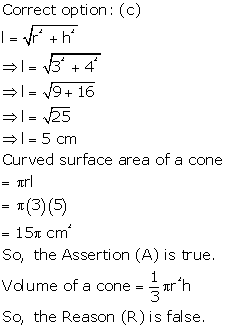Chapter 17 Volume and Surface Areas of Solids
Class 10th R. S. Aggarwal Maths Solution
CBSE Class 10 Maths
R. S. Aggarwal Solution
Exercise Test Yourself
Solution 2
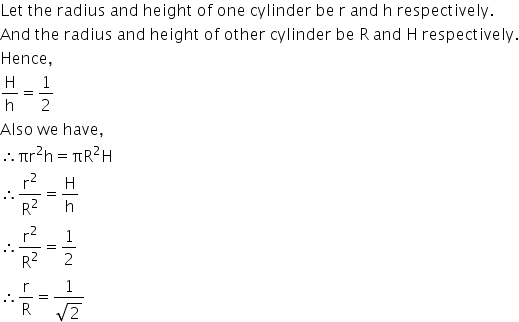
Solution 1
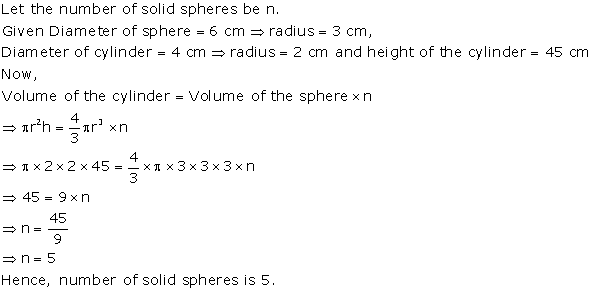
Solution 2
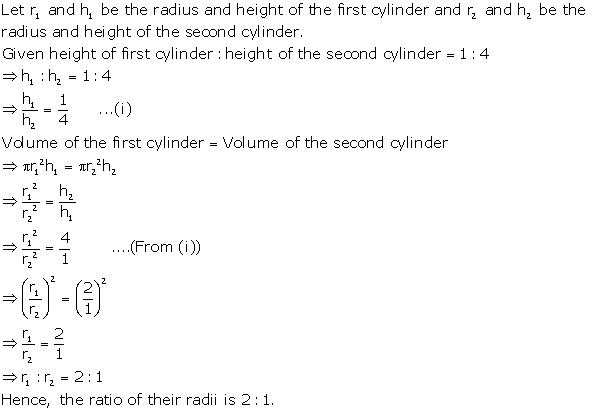
Solution 3
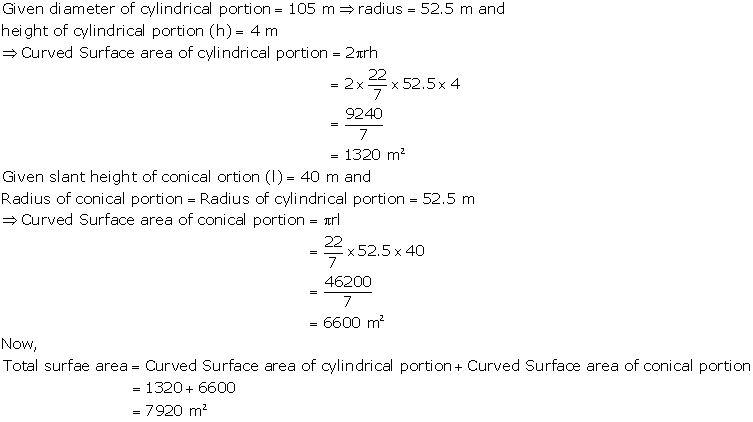
Solution 4
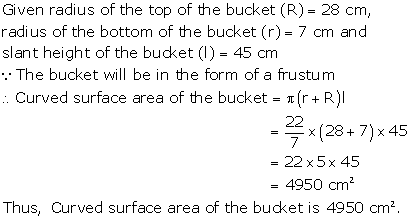
Solution 5
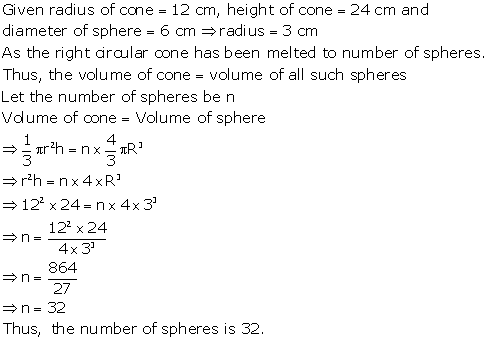
Solution 6
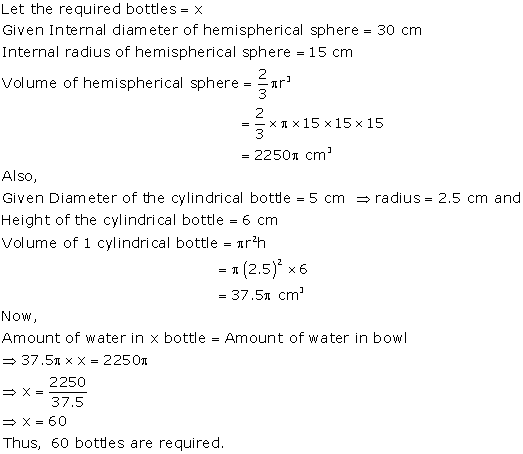
Solution 7
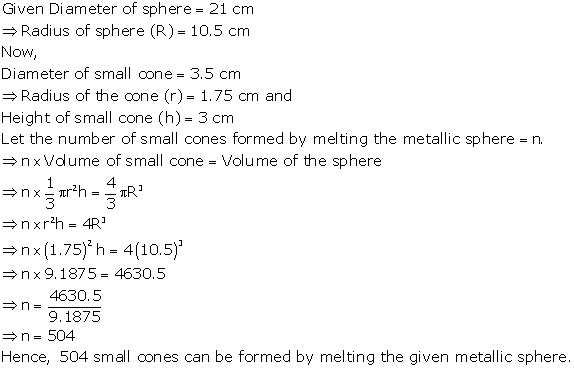
Solution 8
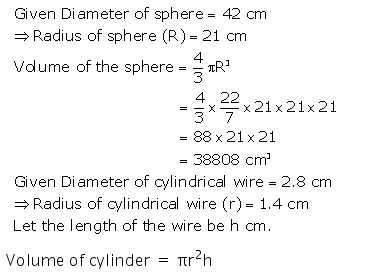
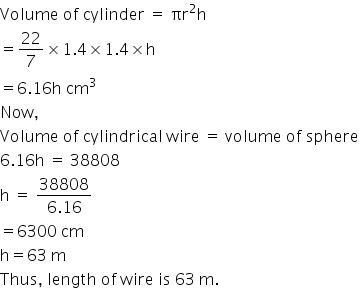
Solution 9
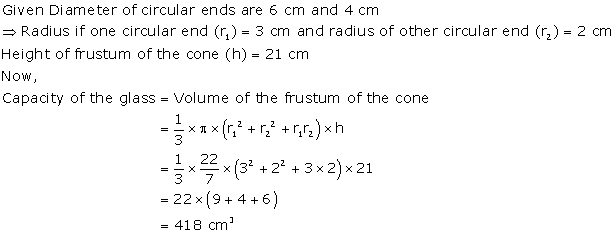
Solution 10
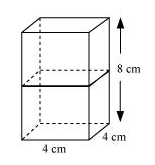
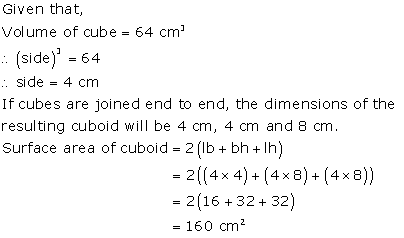
Solution 11
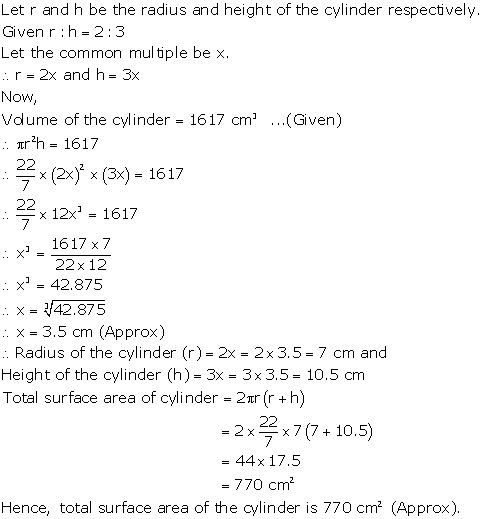
Solution 12
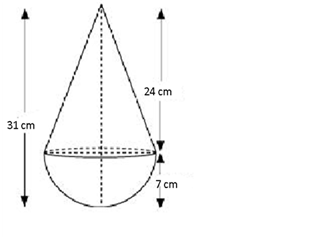
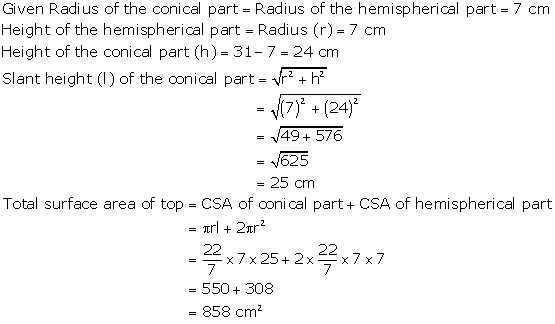
Solution 13
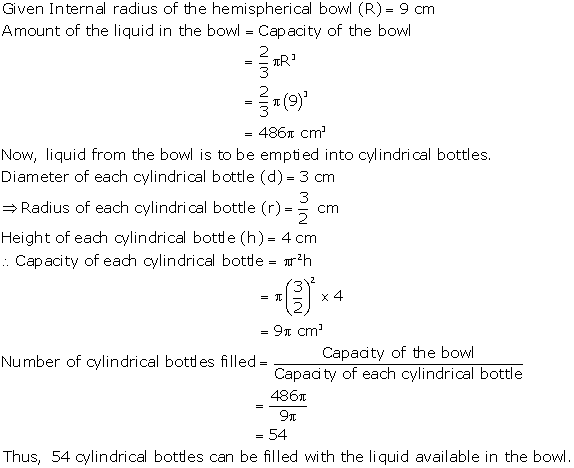
Solution 14
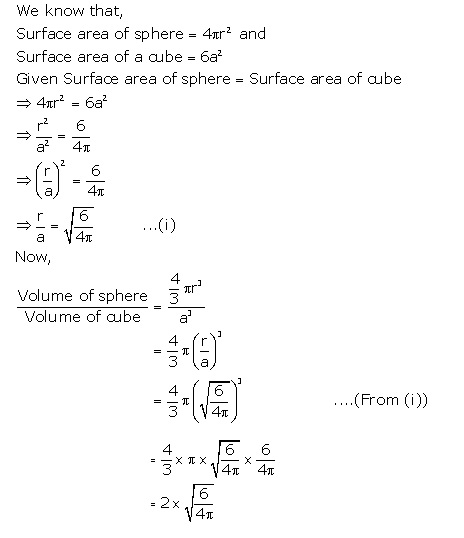
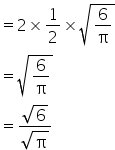
Solution 15
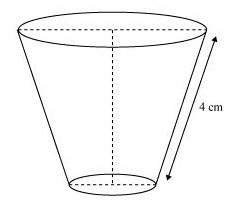
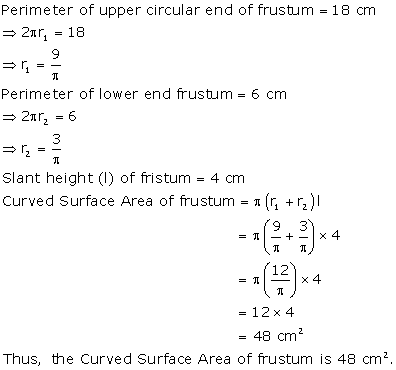
Note: Answer is incorrect in the textbook
Solution 16
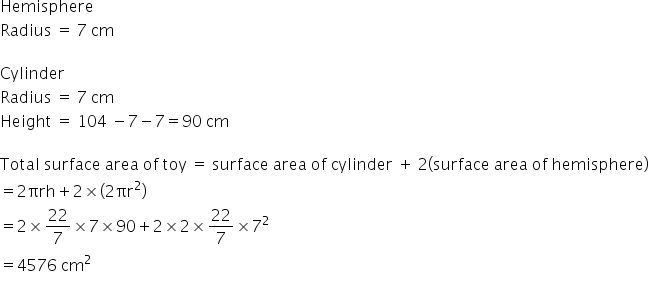
Solution 17
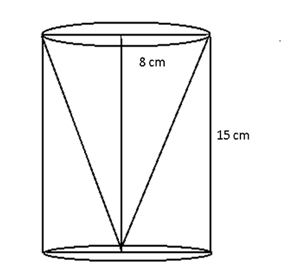

Solution 18
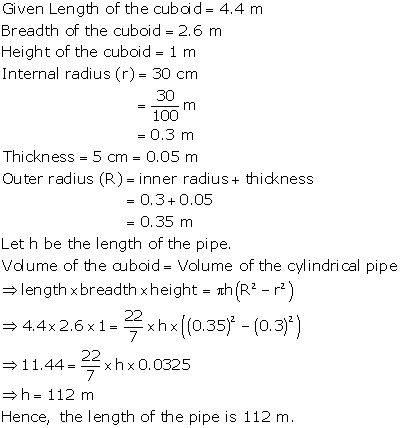
Solution 19
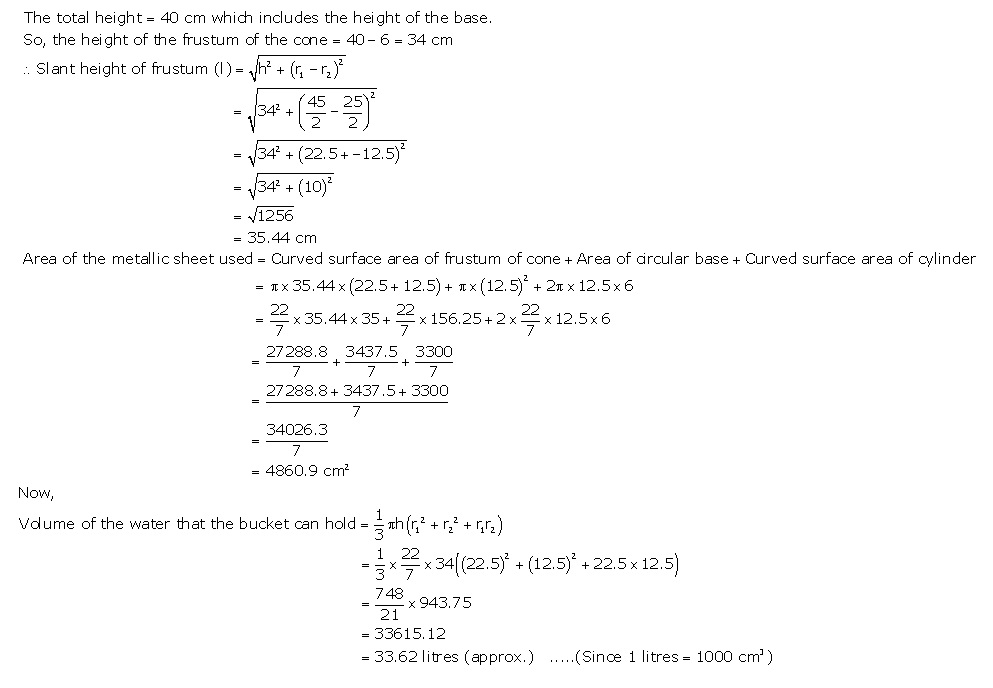
Solution 20
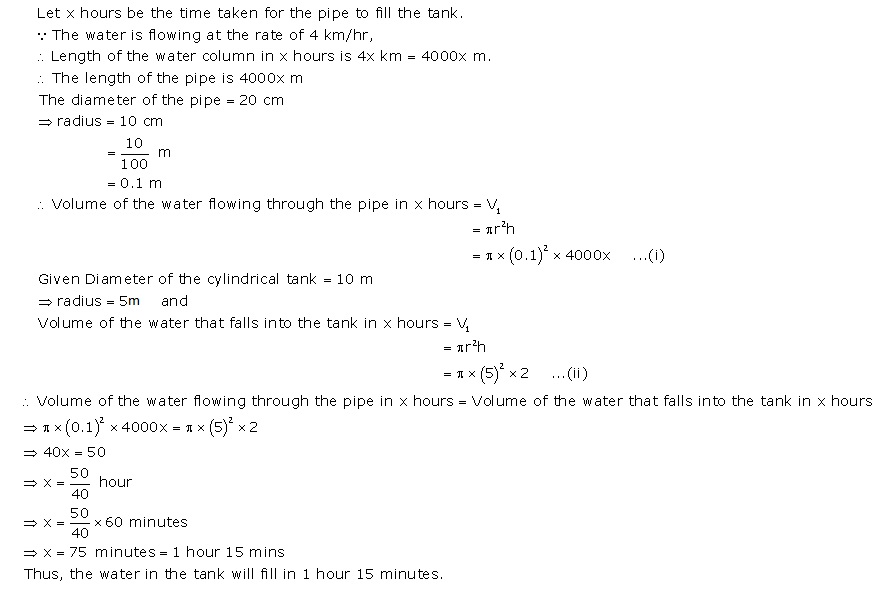
Volume and Surface Areas of Solids Exercise Ex. 17A
Solution 1
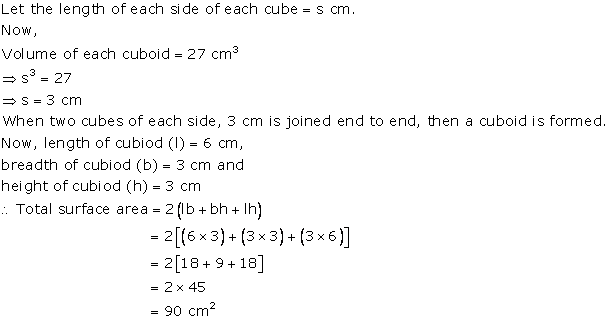
Solution 2
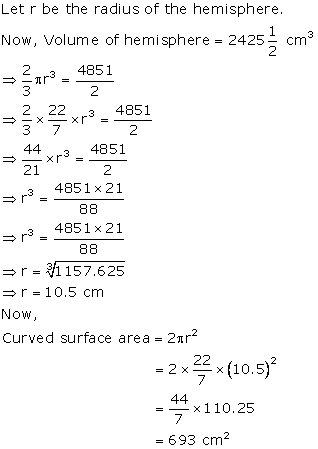
Solution 3
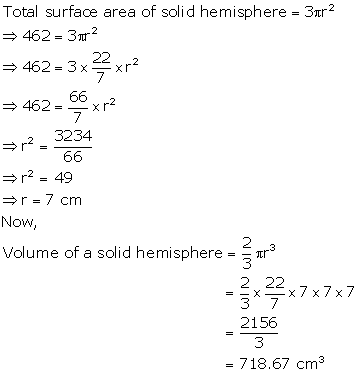
Solution 4(i)
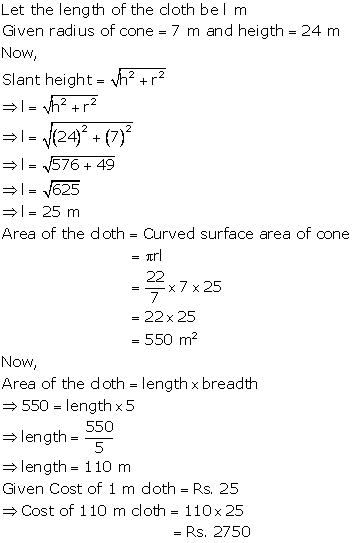
Solution 5
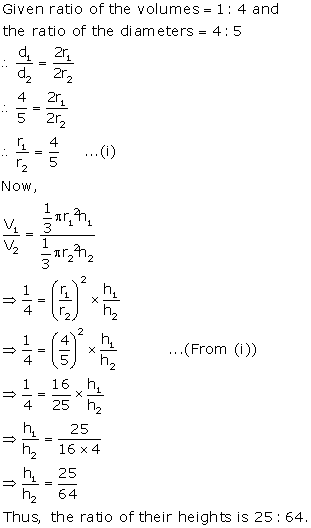
Solution 6
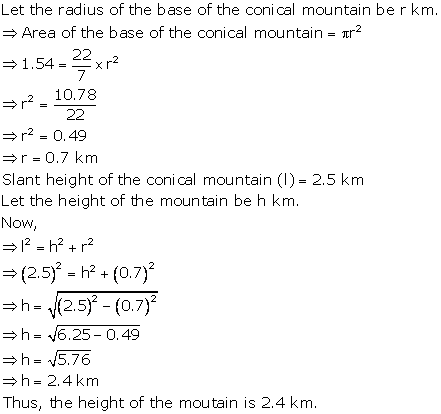
Solution 7
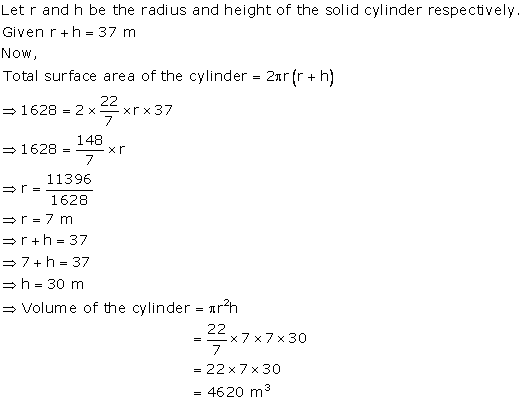
Solution 8
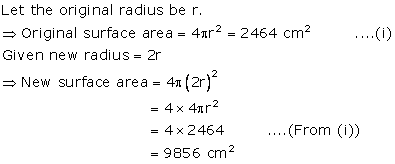
Solution 9
s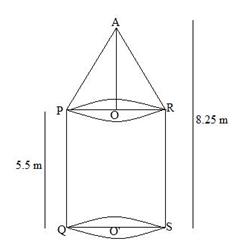
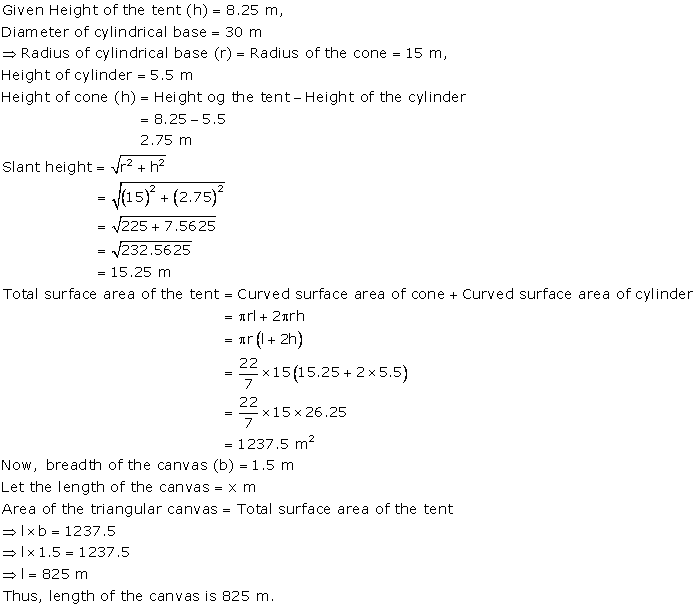
Solution 10
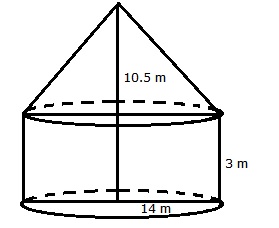
Radius of the cylinder = 14 m
And its height = 3 m
Radius of cone = 14 m
And its height = 10.5 m
Let l be the slant height
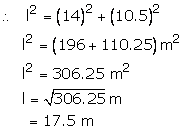
Curved surface area of tent
= (curved area of cylinder + curved surface area of cone)

Hence, the curved surface area of the tent = 1034 ![]()
Cost of canvas = Rs.(1034 × 80) = Rs. 82720
Solution 11
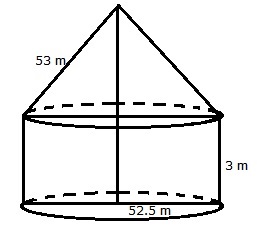
For the cylindrical portion, we have radius = 52.5 m and height = 3 m
For the conical portion, we have radius = 52.5 m
And slant height = 53 m
Area of canvas = 2![]() rh
+
rh
+ ![]() rl
=
rl
= ![]() r(2h
+ l)
r(2h
+ l)

Solution 12
Radius o f cylinder = 2.5 m
Height of cylinder = 21 m
Slant height of cone = 8 m
Radius of cone = 2.5 m
Total surface area of the rocket = (curved surface area of cone
+ curved surface area of cylinder + area of base)
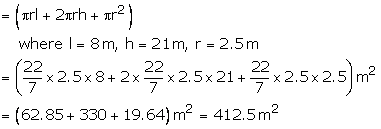
Solution 13
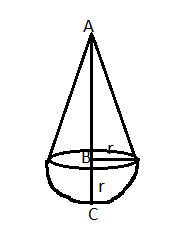
![]()
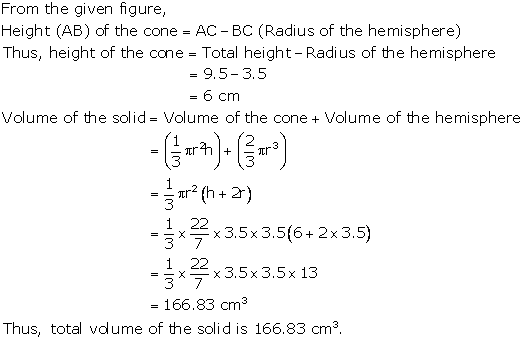
Solution 14
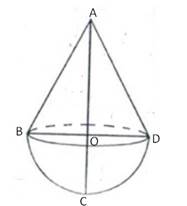
Radius = BO = r = 3.5 cm
Height of toy = AC = 15.5 cm
Height of cone = AO = h = AC - OC = 12 cm
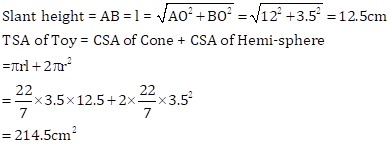
Solution 15
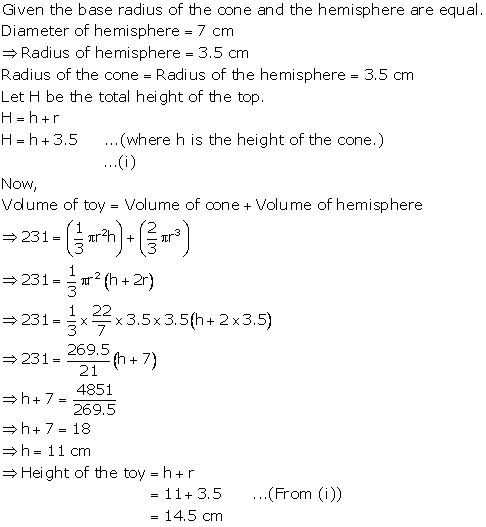
Solution 16
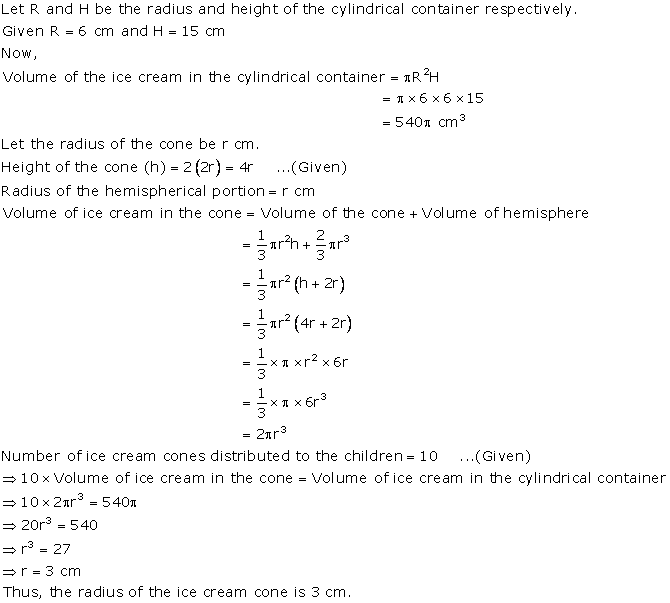
Solution 17
Radius of hemisphere = 10.5 cm
Height of cylinder = (14.5 - 10.5) cm = 4 cm
Radius of cylinder = 10.5 cm
Capacity = Volume of cylinder + Volume of hemisphere

Solution 18
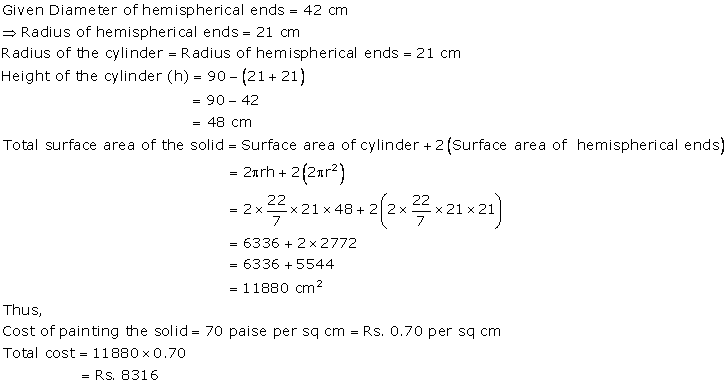
Solution 19
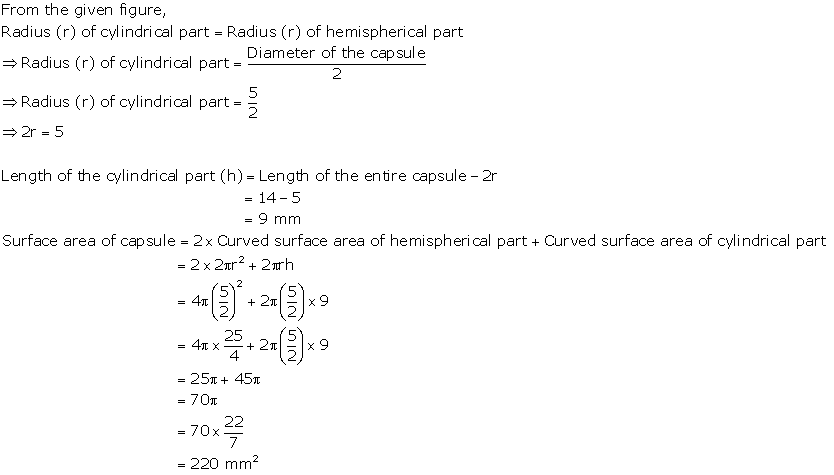
Solution 20
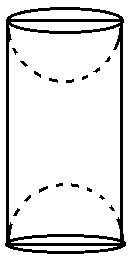
Height of cylinder = 20 cm
And diameter = 7 cm and then radius = 3.5 cm
Total surface area of article
= (lateral surface of cylinder with r = 3.5 cm and h = 20 cm)
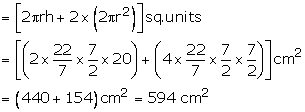
Solution 21
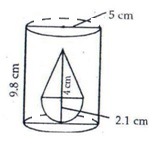
Radius of cylinder ![]()
And height of cylinder ![]()
Radius of cone r = 2.1 cm
And height of cone ![]()
Volume of water left in tub
= (volume of cylindrical tub – volume of solid)

Solution 22
(i)Radius of cylinder = 6 cm
Height of cylinder = 8 cm
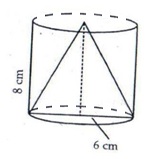
Volume of cylinder

Volume of cone removed
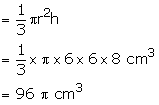
The volume of remaining solid

(ii)Surface area of cylinder = 2![]() = 2
= 2![]() ×
6 × 8
×
6 × 8 ![]()
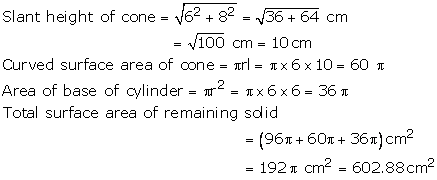
Solution 23
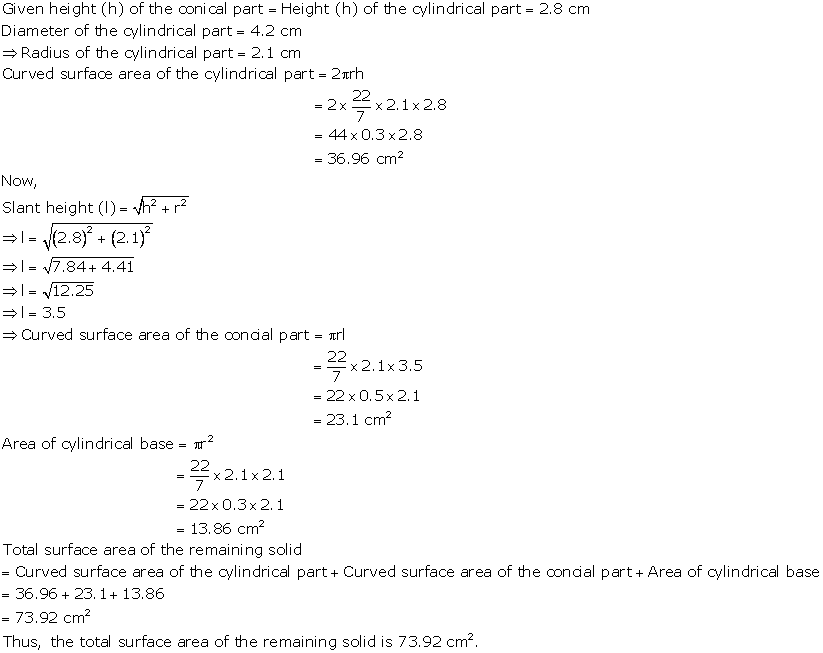
Solution 24
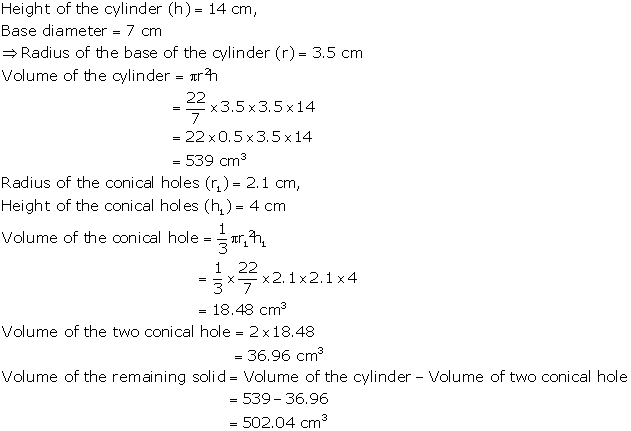
Solution 25
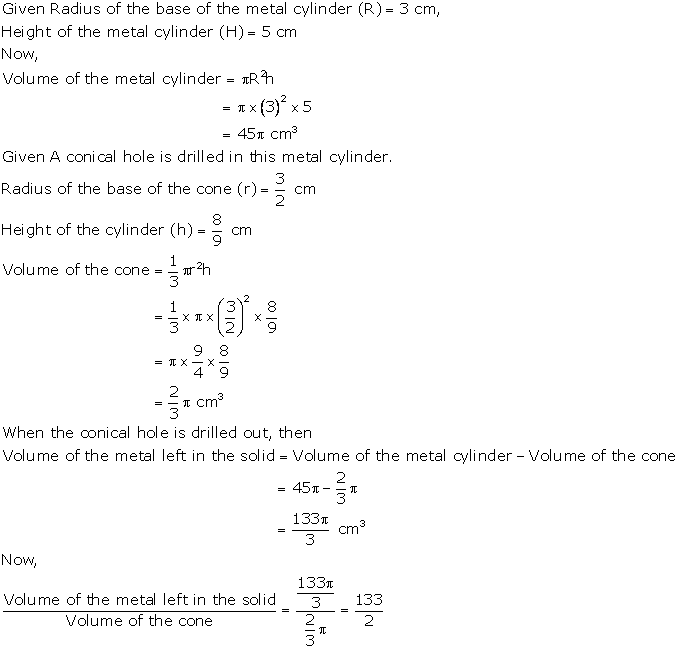
Solution 26
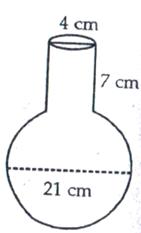
Diameter of spherical part of vessel = 21 cm
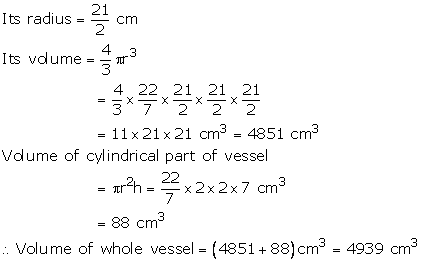
Solution 27
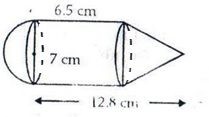
Height of cylinder = 6.5 cm
Height of cone = ![]()
Radius of cylinder = radius of cone
= radius of hemisphere
= ![]()
Volume of solid = Volume of cylinder + Volume of cone
+ Volume of hemisphere
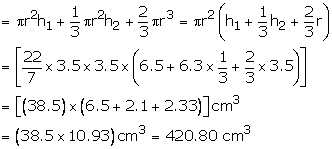
Solution 28
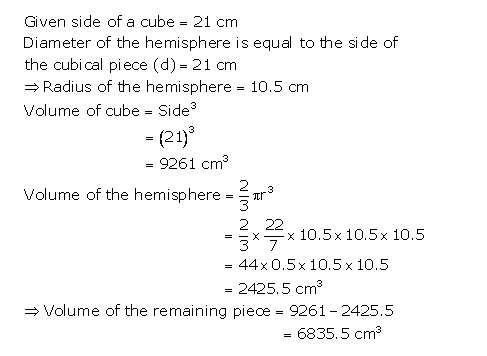
Total surface area of cube = 6(side)2
=6×212
=2646

Now the surface area of the remaining solid = Total surface area of the cube + curved surface area of the hemisphere - Area of the circular base of the hemisphere
=2646 + 693 - 346.5
=2992.5 cm2
Solution 29 (i)
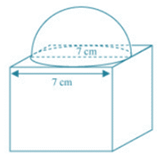
Note: In the question, cuboid is printed, but as the given data is insufficient, we are considering the shape as cube.
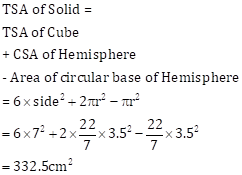
Solution 29(ii)
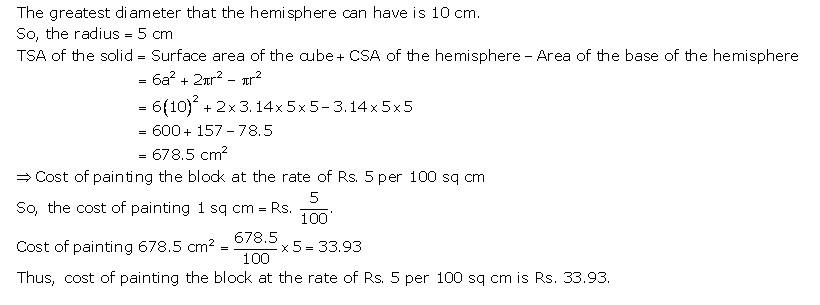
Solution 30

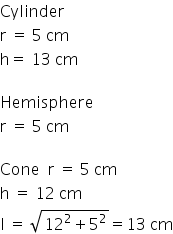

Solution 31
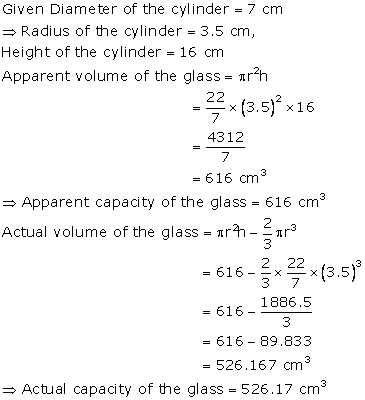
Solution 32
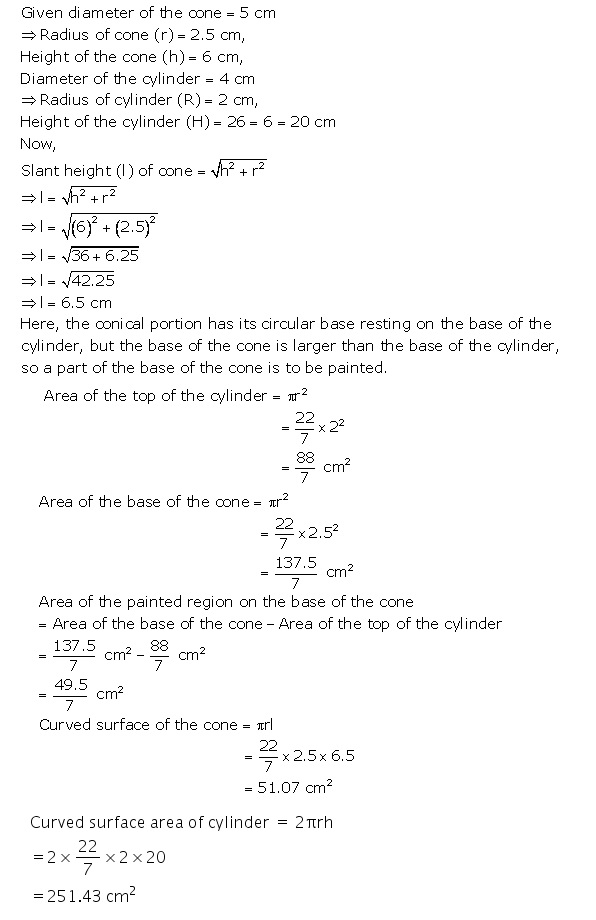

Solution 33
Volume displaced by 1 person = 0.04m3
∴ Volume displaced by 500 persons = 0.04×500 = 20m3
Now,
Volume displaced = Area of tank × height of displacement
Also,
Area of tank = 80×50 m2
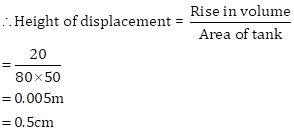
Solution 34
Canal is shaped like a cuboid,
Hence
Volume of water = lbh
Given,
b = 6 m
h = 1.5 m
l = 10 km per hour
= 10000 m per 60 min.
= 5000 m per 30 min.
Hence, volume of water for 30 min.
= 6×1.5×5000
= 45000
Now,
Volume of water = Volume of Area irrigated
45000 = Area irrigated × Height of standing water
Height of standing water required = 8cm = 0.08m
∴ Area irrigated = 45000/0.08
= 562500 m2
Solution 4 (ii)
Let the radius and height be 5x and 12x respectively
Hence
Volume of cone = 314cm3
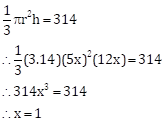
Hence,
Radius = 5cm
Height = 11cm

Volume and Surface Areas of Solids Exercise Ex. 17B
Solution 1
Solid cuboid
l = 9m
b = 8m
h = 2m
Volume = 9×8×2
Solid cube
S = 2m
Volume = s3 = 2×2×2
![]()
Solution 2
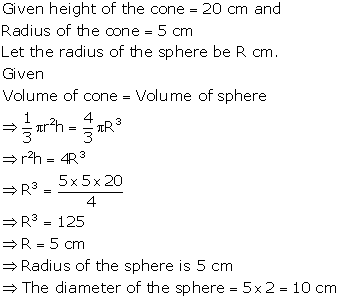
Solution 3
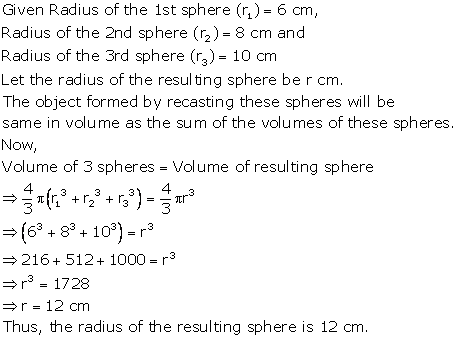
Solution 4
Radius of the cone = 12 cm and its height = 24 cm
Volume of cone = ![]()
![]()

Solution 5
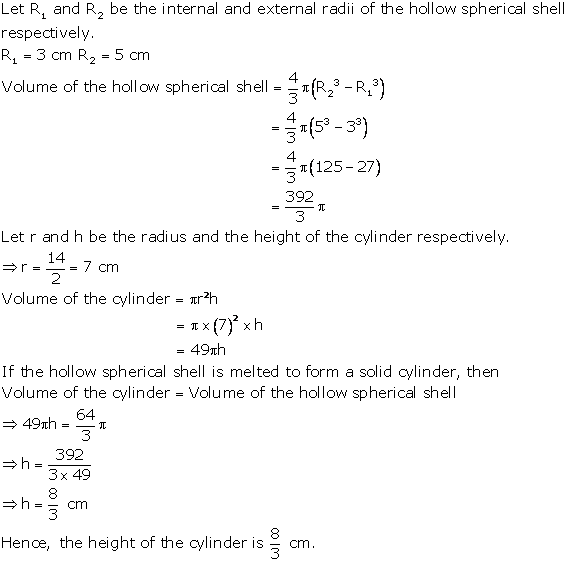
Solution 6
Internal radius = 3 cm and external radius = 5 cm
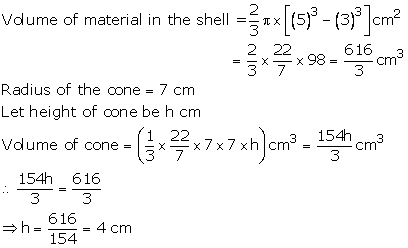
Hence, height of the cone = 4 cm
Solution 7
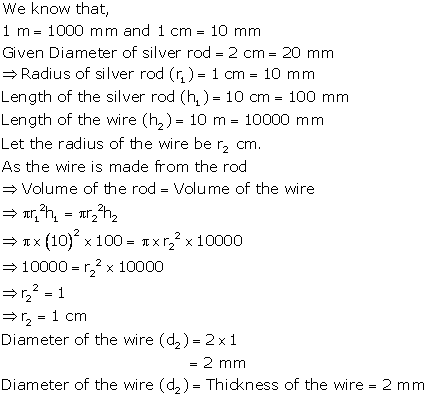
Solution 8
Inner radius of the bowl = 15 cm
Volume of liquid in it = ![]()
Radius of each cylindrical bottle = 2.5 cm and its height = 6 cm
Volume of each cylindrical bottle
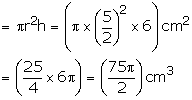
Required number of bottles = ![]()

Hence, bottles required = 60
Solution 9
Radius of the sphere= ![]()
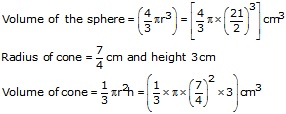
Let the number of cones formed be n, then
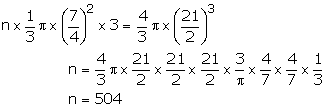
Hence, number of cones formed = 504
Solution 10
Radius of the cannon ball = 14 cm
Volume of cannon ball = ![]()
Radius of the cone = ![]()
Let the height of cone be h cm
![]() Volume
of cone =
Volume
of cone = 
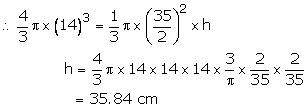
Hence, height of the cone = 35.84 cm
Solution 11
Let the radius of the third ball be r cm, then,
Volume of third ball = Volume of spherical ball volume of 2 small balls
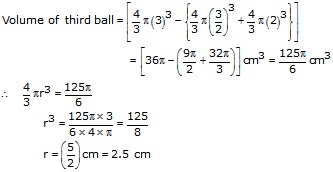
Solution 12
External radius of shell = 12 cm and internal radius = 9 cm
Volume of lead in the shell = ![]()
Let the radius of the cylinder be r cm
Its height = 37 cm
Volume of cylinder = ![]()
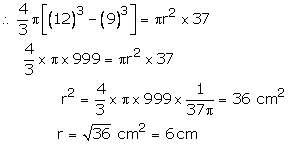
Hence diameter of the base of the cylinder = 12 cm
Solution 13
Volume of hemisphere of radius 9 cm
![]()
Volume of circular cone (height = 72 cm)
![]()
Volume of cone = Volume of hemisphere
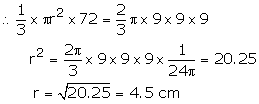
Hence radius of the base of the cone = 4.5 cm
Solution 14
Diameter of sphere = 21 cm
Hence, radius of sphere = ![]()
Volume of sphere = ![]() =
= ![]()
Volume of cube = a3 = (1×1×1)
![]()
Let number of cubes formed be n
![]() Volume
of sphere = n Volume of cube
Volume
of sphere = n Volume of cube

Hence, number of cubes is 4851.
Solution 15
Volume of sphere (when r = 1 cm) = ![]() =
= ![]()
Volume of sphere (when r = 8 cm) = ![]() =
= ![]()
Let the number of balls = n

Solution 16
Radius of sphere = 3 cm
Volume of sphere = ![]()
Radius of small sphere = ![]()
Volume of small sphere = ![]()

Let number of small balls be n

Hence, the number of small balls = 1000.
Solution 17
Diameter of sphere = 42 cm
Radius of sphere = ![]()
Volume of sphere = ![]()
Diameter of cylindrical wire = 2.8 cm
Radius of cylindrical wire = ![]()
Volume of cylindrical wire = ![]()
![]()
Volume of cylindrical wire = volume of sphere
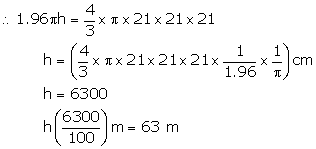
Hence length of the wire 63 m.
Solution 18
Diameter of sphere = 18 cm

Length of wire = 108 m = 10800 cm
Let the radius of wire be r cm
![]()
But the volume of wire = Volume of sphere

Hence the diameter = 2r = (0.3 × 2) cm = 0.6 cm
Solution 19
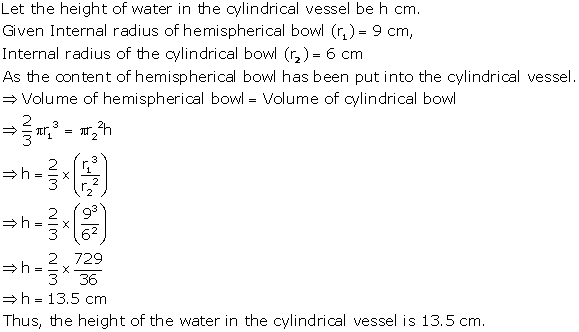
Solution 20
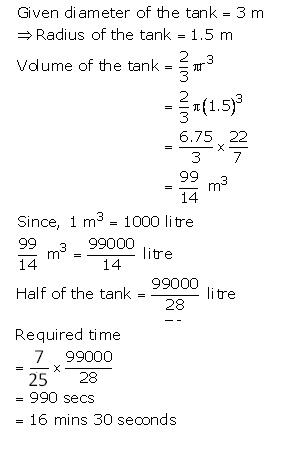
Solution 21
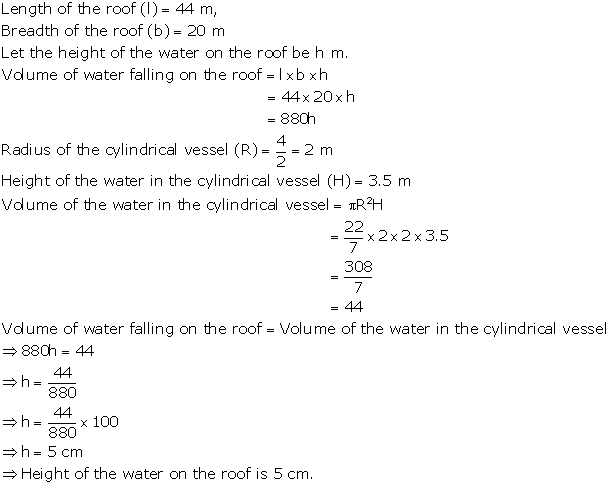
Solution 22
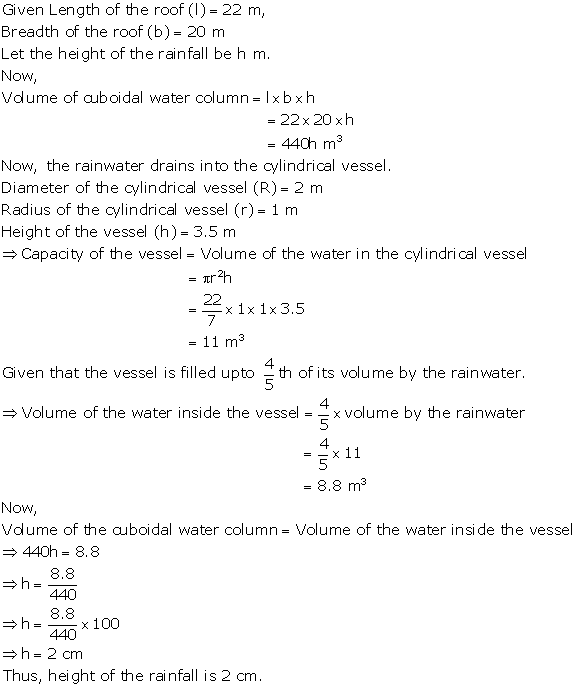
Solution 23
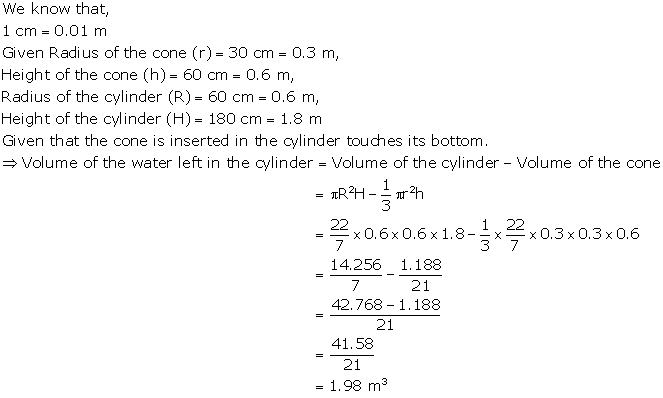
Solution 24
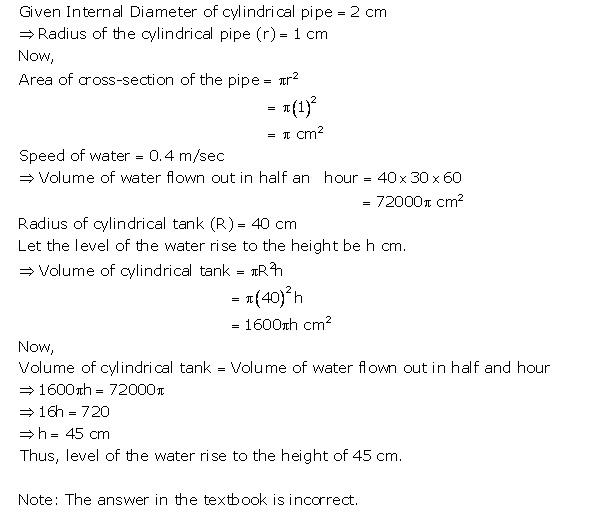
Solution 25
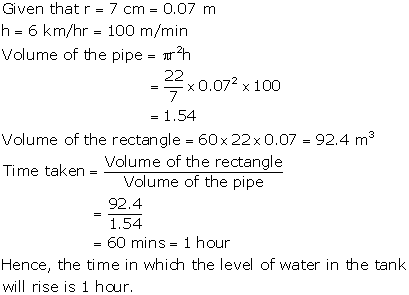
Solution 26
Canal is shaped like a cuboid,
Hence
Volume of water = lbh
Given,
b = 5.4 m
h = 1.8 m
l = 25 km per hour
= 25000 m per 60 min.
= ![]() m per 40 min.
m per 40 min.
Hence, volume of water for 30 min.

Now,
Volume of water = Volume of Area irrigated
162000 = Area irrigated × Height of standing water
Height of standing water required = 10cm = 0.1m
∴ Area irrigated = 162000/0.1
= 1620000 m2
Solution 27
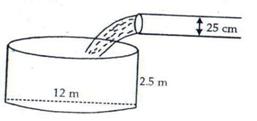
Height of cylindrical tank = 2.5 m
Its diameter = 12 m, Radius = 6 m
Volume of tank = ![]()
Water is flowing at the rate of 3.6 km/ hr = 3600 m/hr
Diameter of pipe = 25 cm, radius = 0.125 m
Volume of water flowing per hour

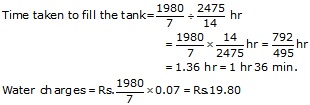
Solution 28
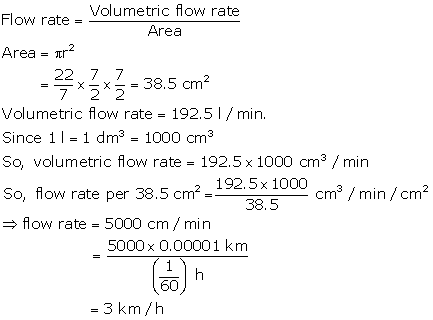
Solution 29
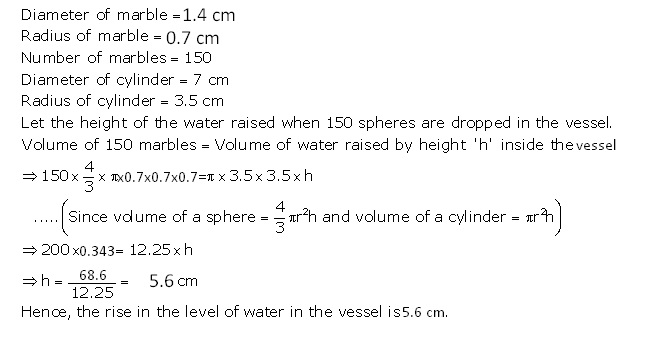
Solution 30
![]()
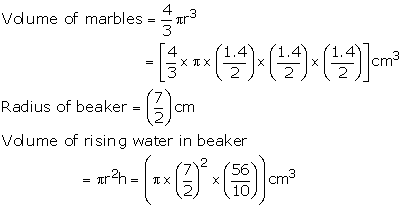
Let the number of marbles be n
![]() n
volume of marble = volume of rising water in beaker
n
volume of marble = volume of rising water in beaker

Solution 31
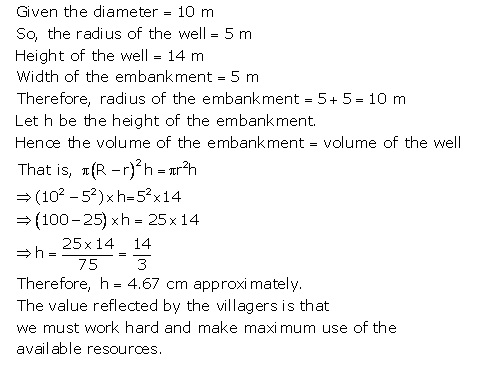
Solution 32
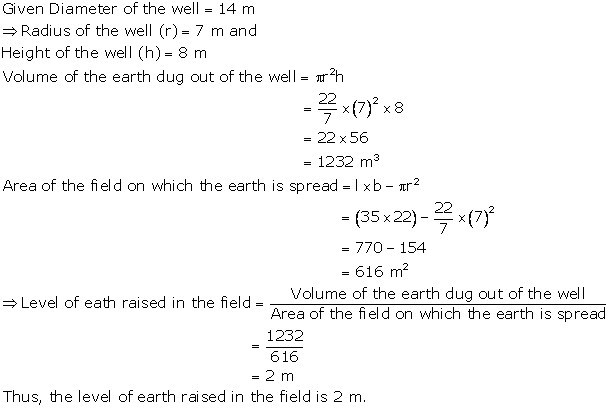
Solution 33
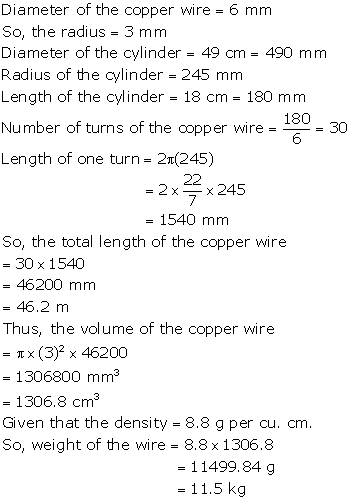
Solution 34
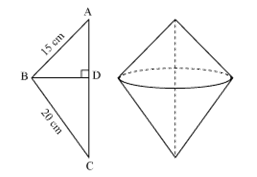
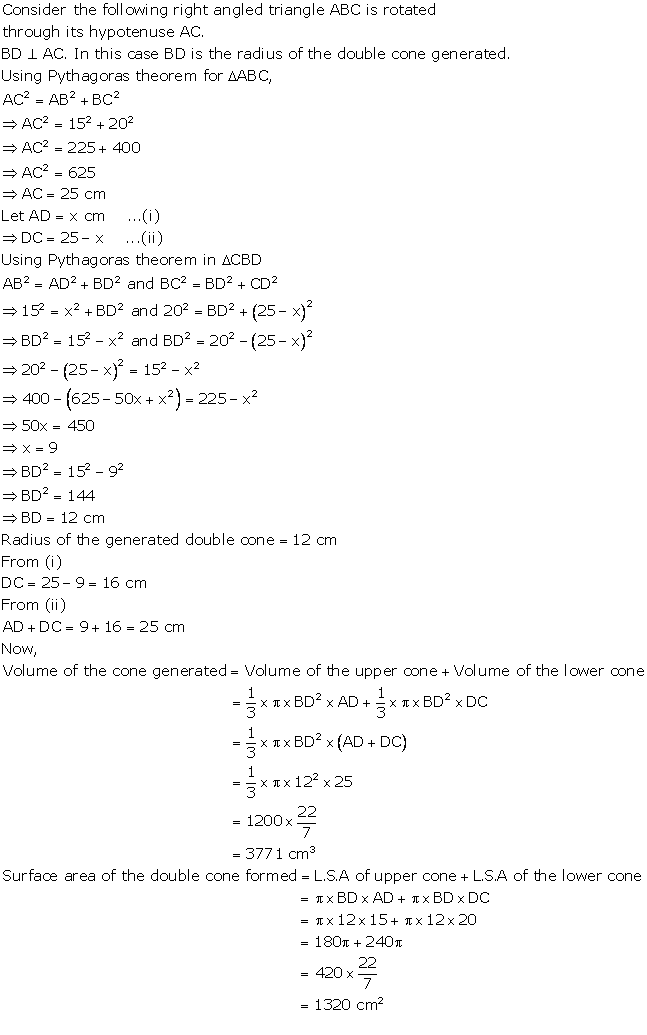
Solution 35
Cylindrical tank
d = 2 m
r = 1 m
h = 5 m

Volume of water for irrigation = Area of park × Standing water height
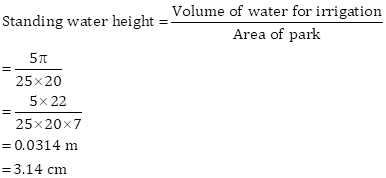
Recycling of water is a need of hour, since the reserves of fresh water are depleting very fast due to increase in population, manufacturing, production etc. We should keep the wastage of water minimum and recycle them as much as we can.
Volume and Surface Areas of Solids Exercise Ex. 17C
Solution 1
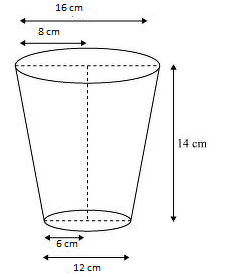
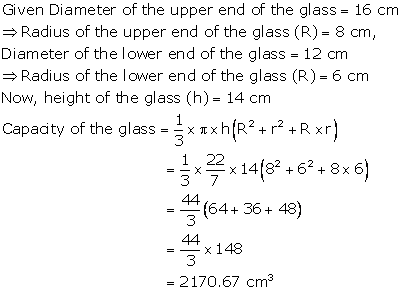
Solution 2
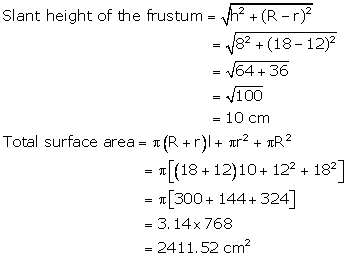
Solution 3
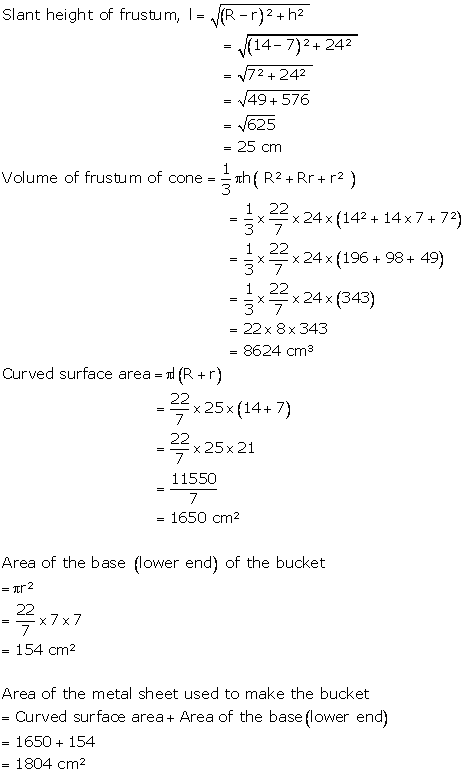
Solution 4
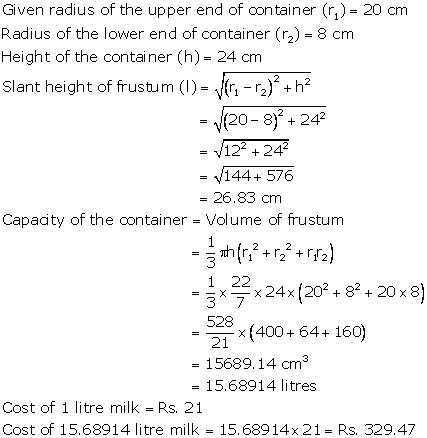
Solution 5
(i)
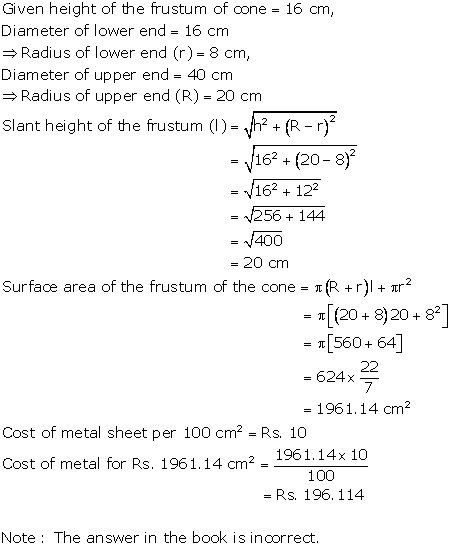
(ii)
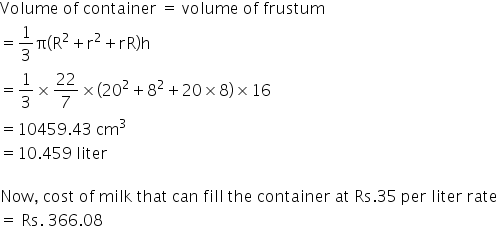
Solution 6
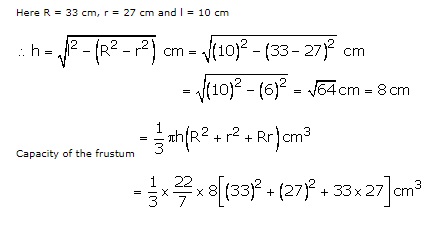
= 22704 cm3
Total surface area = ![]()
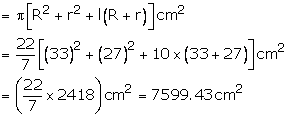
Solution 7
Height = 15 cm, R = ![]() and
and ![]()
Capacity of the bucket = ![]()

Quantity of water in bucket = 28.49 litres
Solution 8
R = 20 cm, r = 8 cm and h = 16 cm

Total surface area of container = ![]()
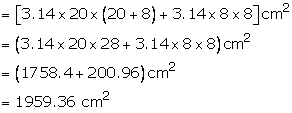
Cost of metal sheet used = ![]()
Solution 9
R = 15 cm, r = 5 cm and h = 24 cm

(i)Volume of bucket = ![]()

Cost of milk = Rs. (8.164 20) = Rs. 163.28
(ii)Total surface area of the bucket

Cost of sheet = ![]()
Solution 10
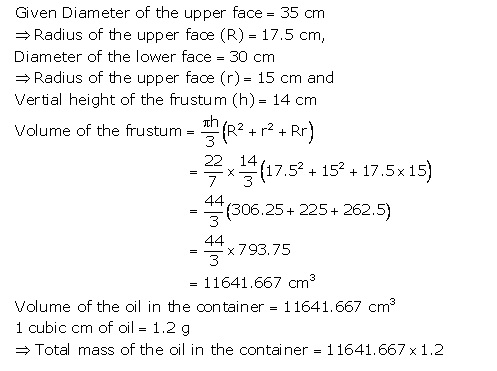
= 13970g
= 13.97kg
The total cost of the oil in the container = 13.97×40 = Rs. 558.80
Solution 11
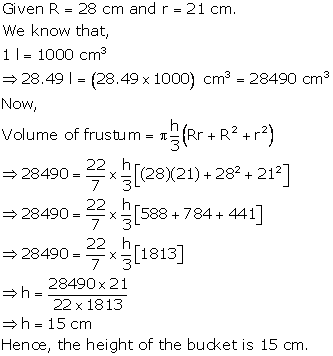
Solution 12
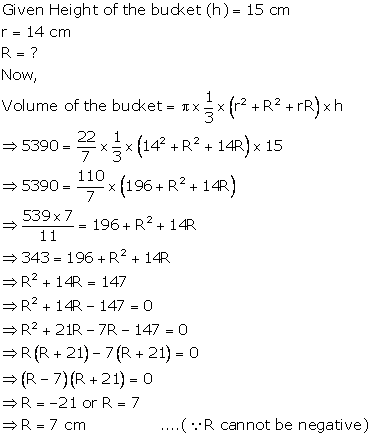
Solution 13
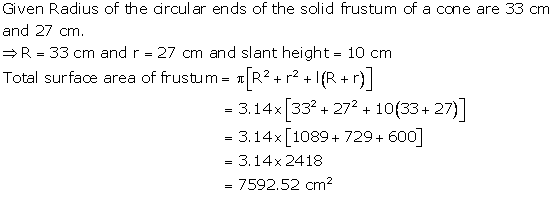
Solution 14
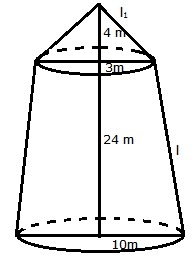
R = 10cm, r = 3 m and h = 24 m
Let l be the slant height of the frustum, then
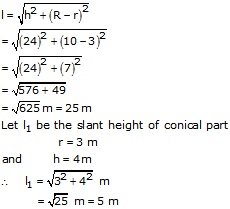
Quantity of canvas = (Lateral surface area of the frustum)
+ (lateral surface area of the cone)

Solution 15
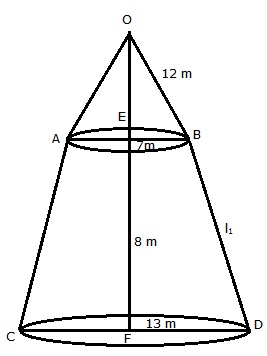
ABCD is the frustum in which upper and lower radii are EB = 7 m and FD = 13 m
Height of frustum= 8 m
Slant height ![]() of
frustum
of
frustum
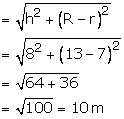
Radius of the cone = EB = 7 m
Slant height ![]() of
cone = 12 m
of
cone = 12 m
![]() Surface
area of canvas required
Surface
area of canvas required
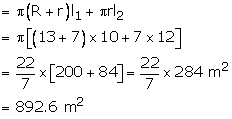
Solution 16
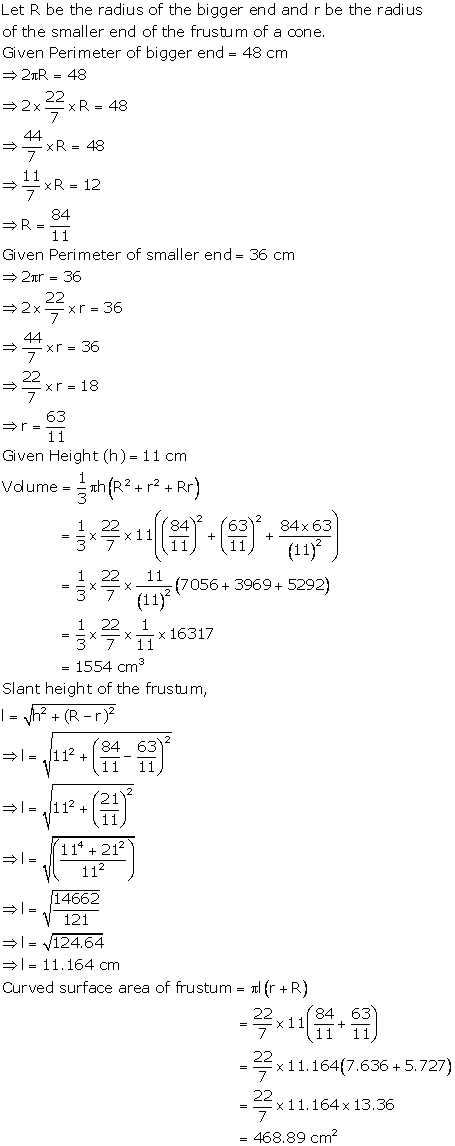
Solution 17
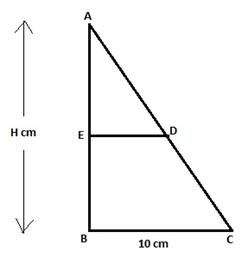
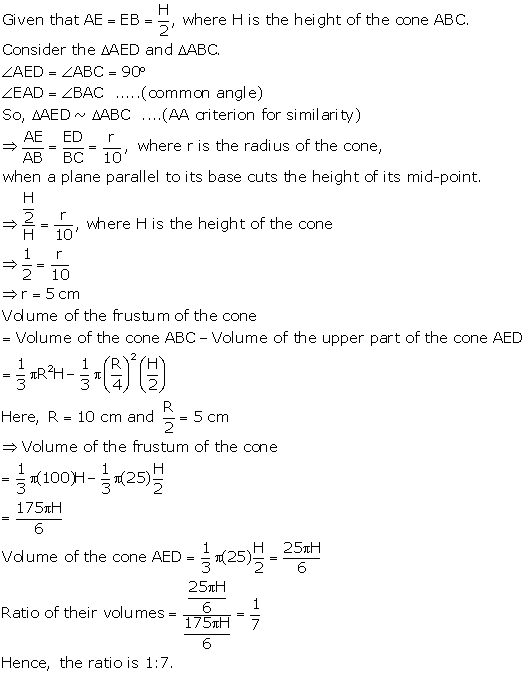
Solution 18
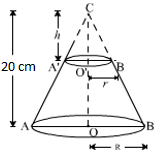
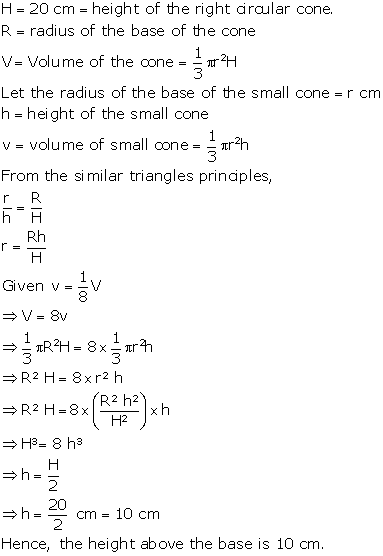
Solution 19
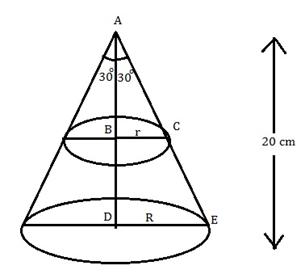
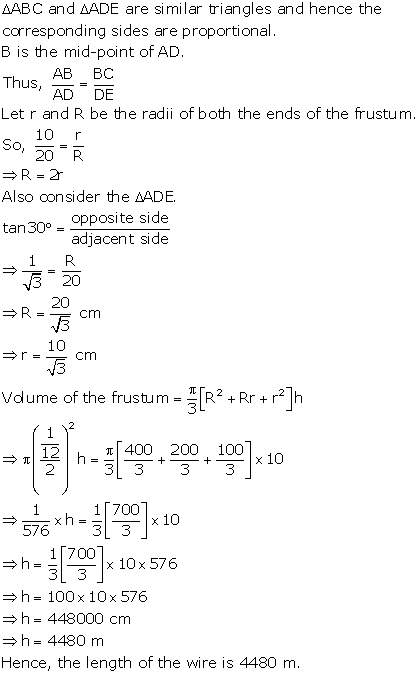
Solution 20

Solution 21
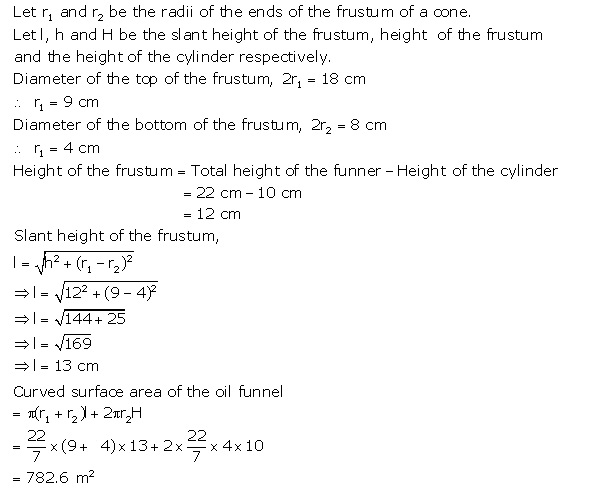
Solution 22
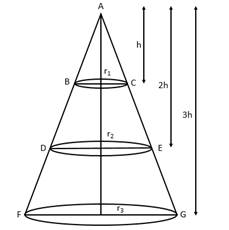
We have,
cone ABC with radius 'r1' and height 'h'
cone ADE with radius 'r2' and height '2h'
cone AFG with radius 'r3' and height '3h'
Now,
∆ABC ~ ∆ADE,

∆ABC ~ ∆AFG,

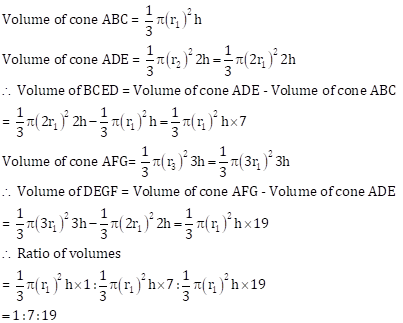
Volume and Surface Areas of Solids Exercise Ex. 17D
Solution 1
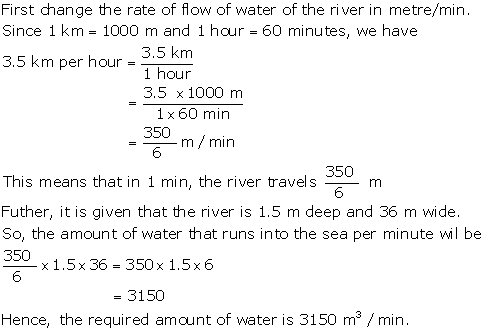
Solution 2
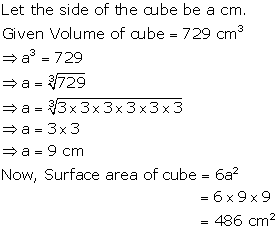
Solution 3
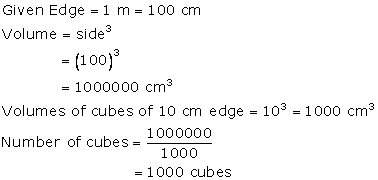
Solution 4
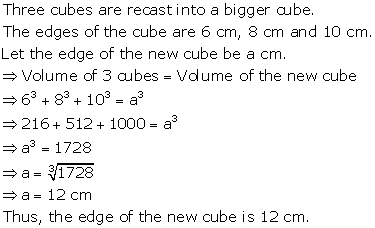
Solution 5
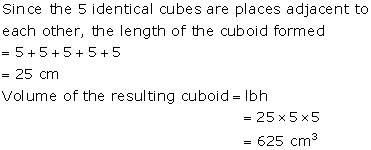
Solution 6
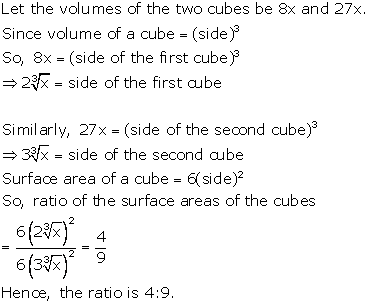
Solution 7
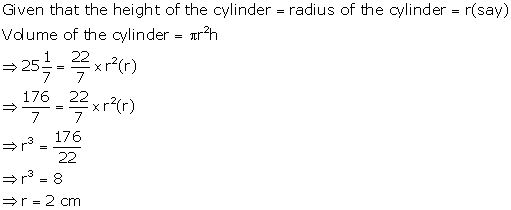
Solution 8
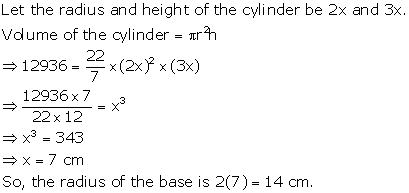
Solution 9
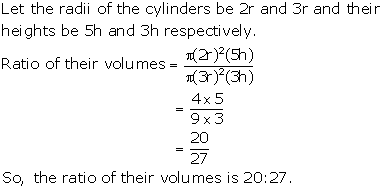
Solution 10
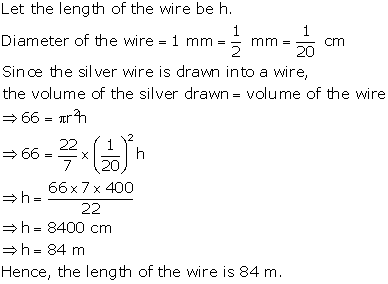
Solution 11
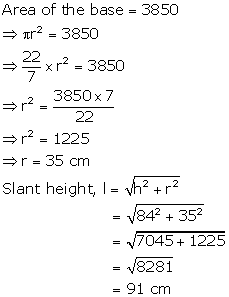
Solution 12
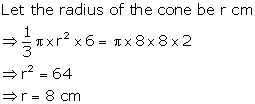
Solution 13

Solution 14
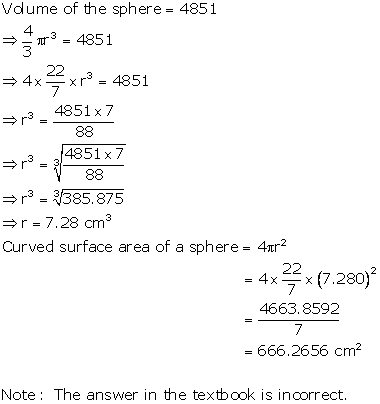
Solution 15
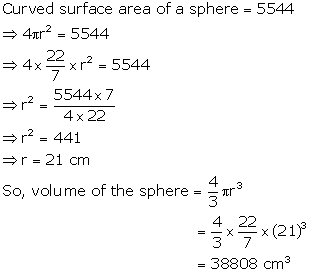
Solution 16
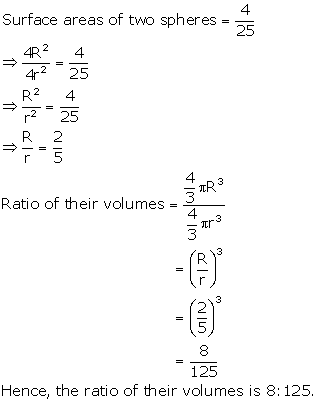
Solution 17
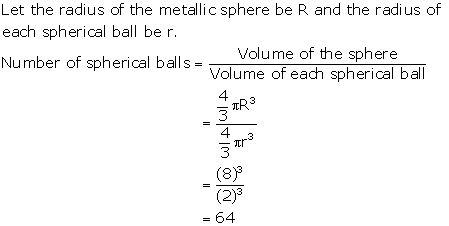
Solution 18
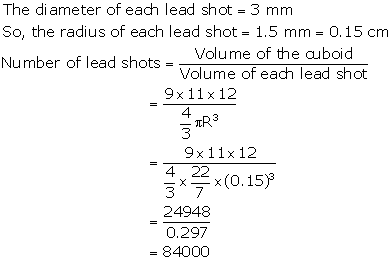
Solution 19
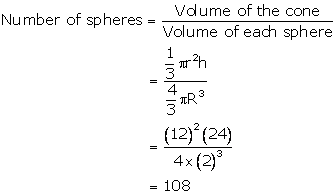
Solution 20
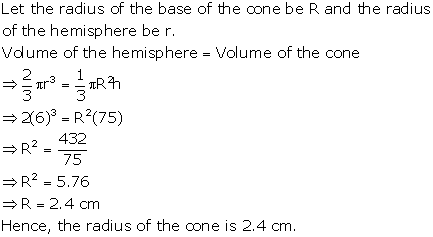
Solution 21
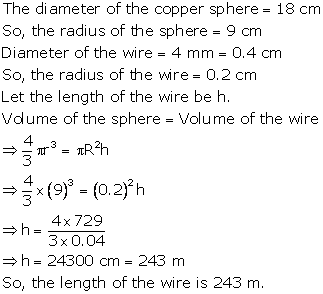
Solution 22
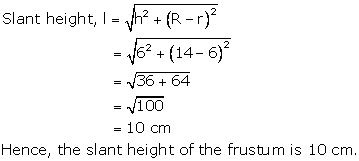
Solution 23
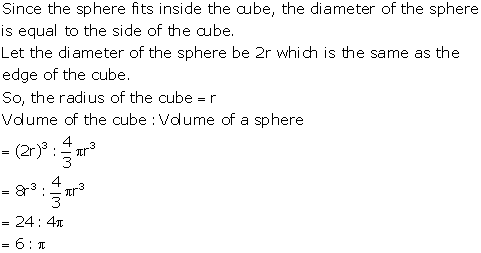
Solution 24
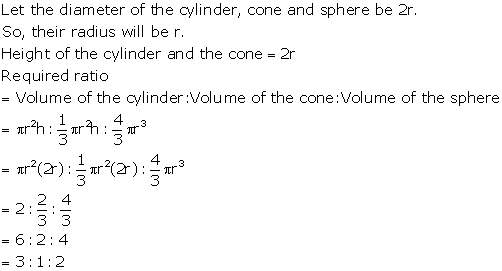
Solution 25
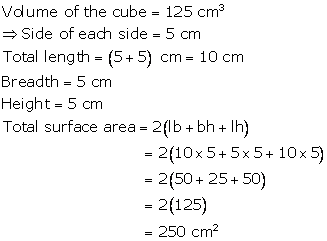
Solution 26
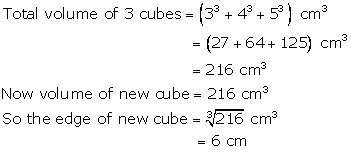
Solution 27
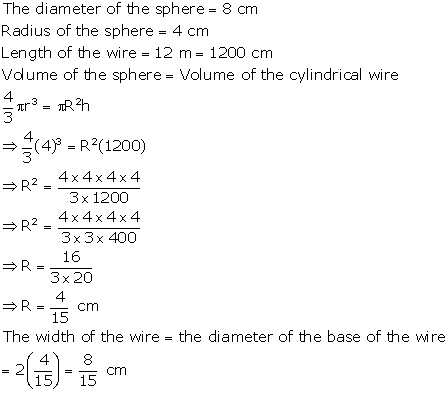
Solution 28
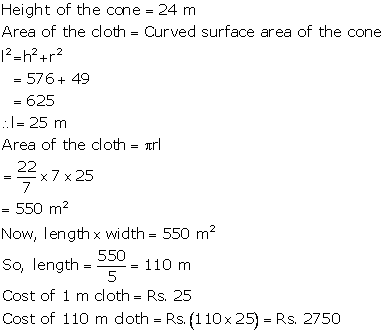
Solution 29
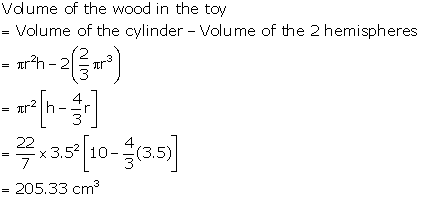
Solution 30
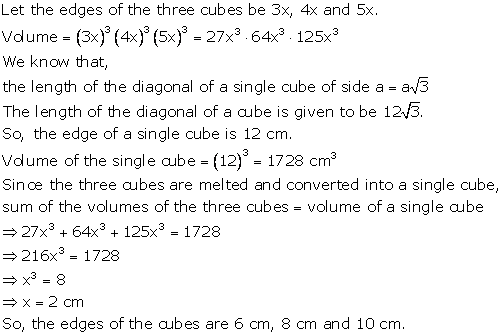
Solution 31
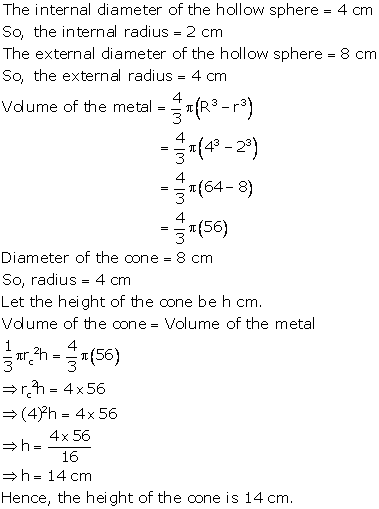
Solution 32
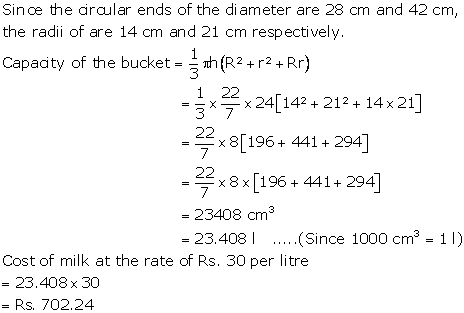
Solution 33
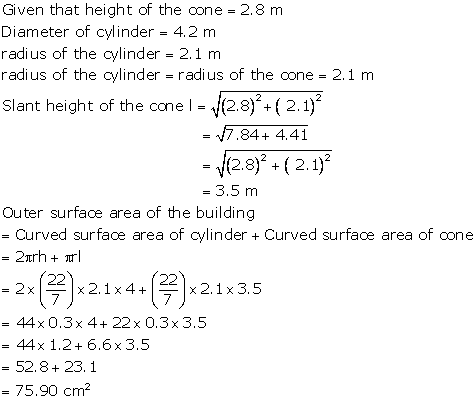
Solution 34
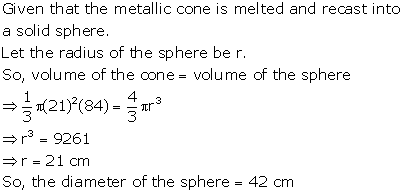
Solution 35
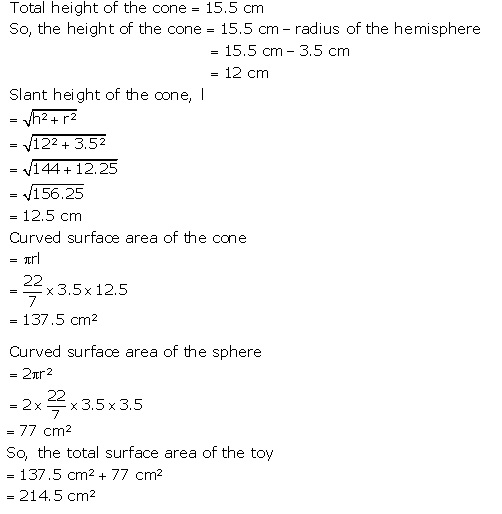
Solution 36
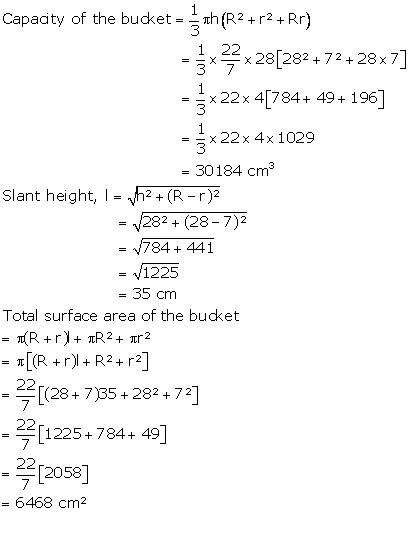
Solution 37
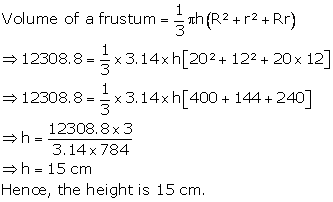
Solution 38
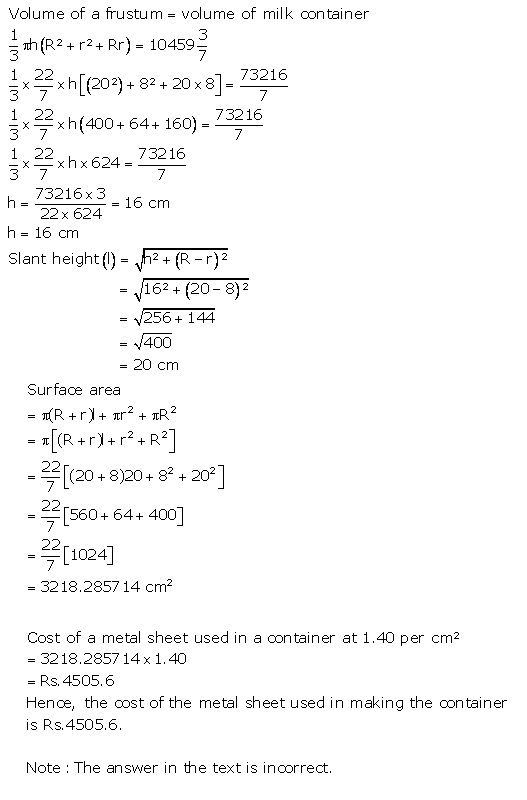
Solution 39
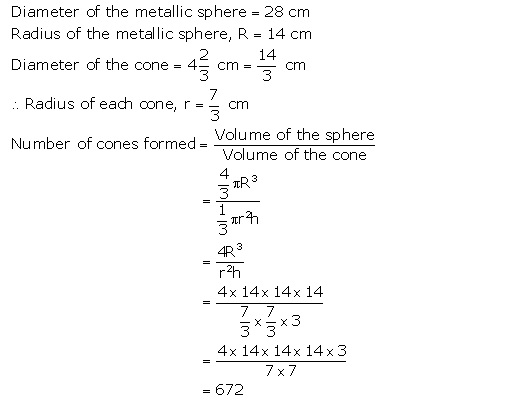
Solution 40
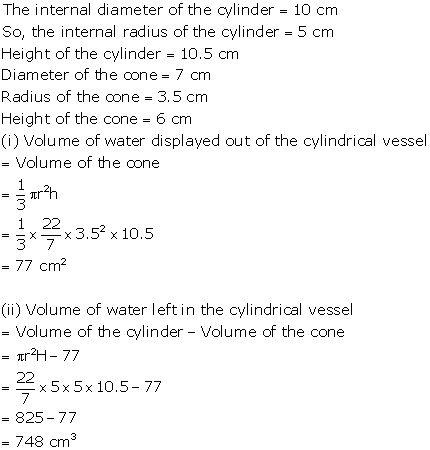
Volume and Surface Areas of Solids Exercise MCQ
Solution 1
Correct option: (a)
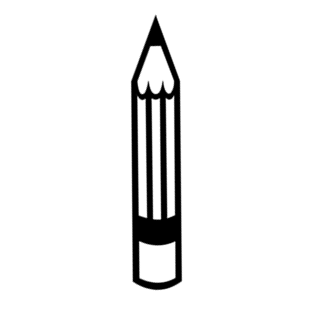
A cylindrical pencil sharpened at one edge is the combination of a cylinder and a cone. Observe the figure, the lower portion is a cylinder and the upper tapering portion is a cone.
Solution 2
Correct option: (b)
A shuttlecock used for playing badminton is the combination of a frustum of a cone and a hemisphere, the lower portion being the hemisphere and the portion above that being the frustum of the cone.
Solution 3
Correct option: (c)
A funnel is the combination of a cylinder and frustum of a cone. The lower portion is cylindrical and the upper portion is a frustum of a cone.
Solution 4
Correct option: (a)
A surahi is a combination of a sphere and a cylinder, the lower portion is the sphere and the upper portion is the cylinder.
Solution 5
Correct option: (b)
The shape of a glass (tumbler) is usually in the form of a frustum of a cone.
Solution 6
Correct option: (c)
The shape of a gill in the gilli-danda game is a combination of two cones and a cylinder. The cones at either ends with the cylinder in the middle.
Solution 7
Correct option: (a)
A plumbline (sahul) is the combination of a hemisphere and a cone, the hemisphere being on top and the lower portion being the cone.
Solution 8
Correct option: (d)
A cone is cut by a plane parallel to its base and the upper part is removed. The part that is left over is called the frustum of a cone.
Solution 9
Correct option: (c)
During conversion of a solid from one shape to another, the volume of the new shape will remain altered.
Solution 10
Correct option: (c)
In a right circular cone, the cross section made by a plane parallel to the base is a circle.
Solution 11
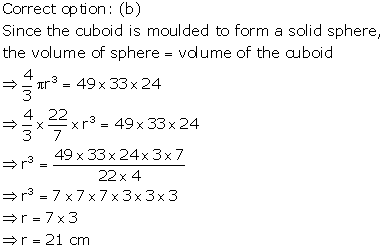
Solution 12

Solution 13
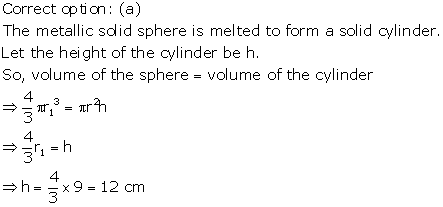
Solution 14
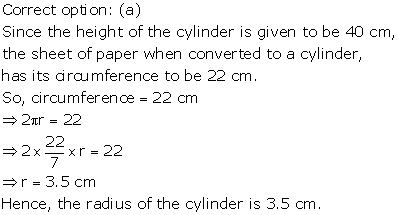
Solution 15
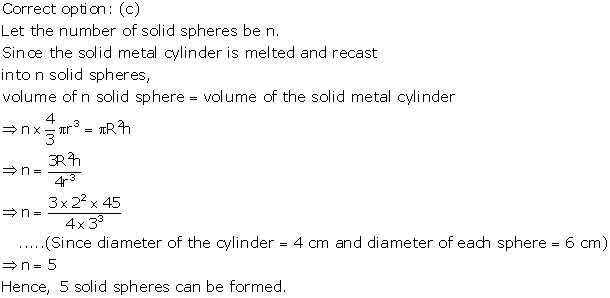
Solution 16
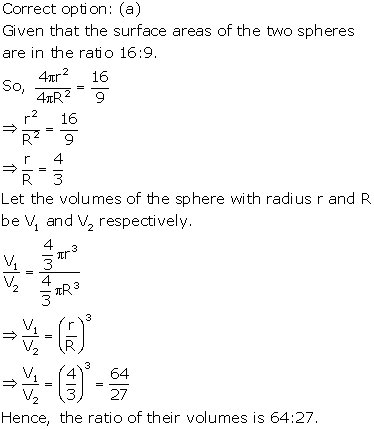
Solution 17
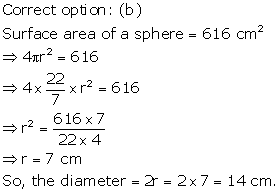
Solution 18

Solution 19
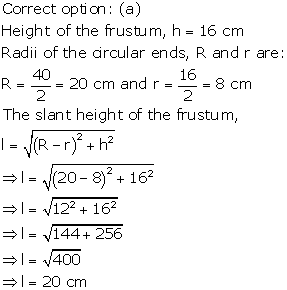
Solution 20
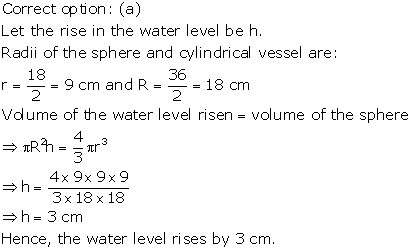
Solution 21
![]()
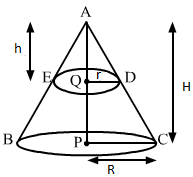
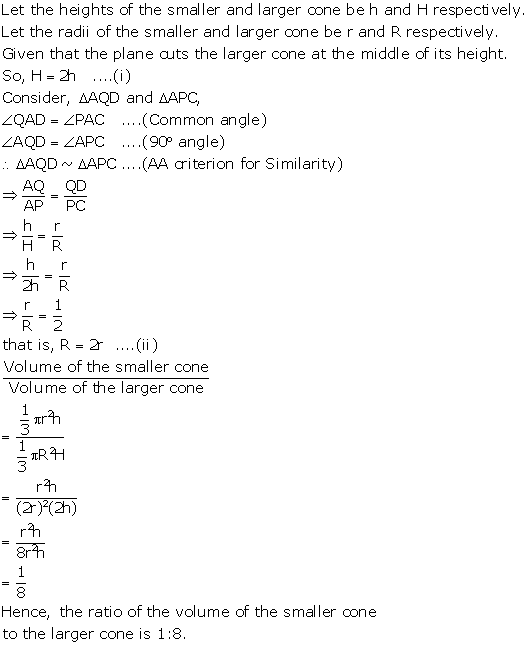
Solution 22
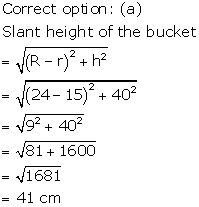
Solution 23
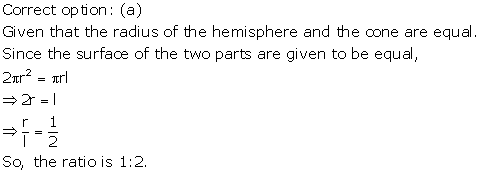
Solution 24
Correct option: (c)
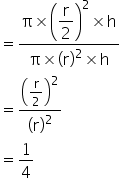
Solution 25
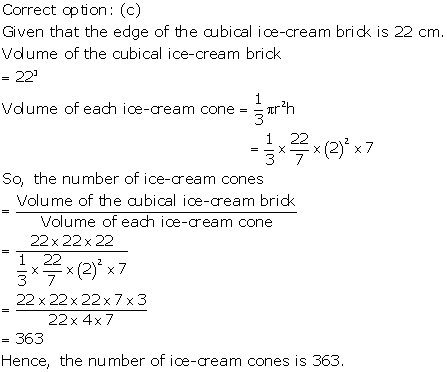
Solution 26
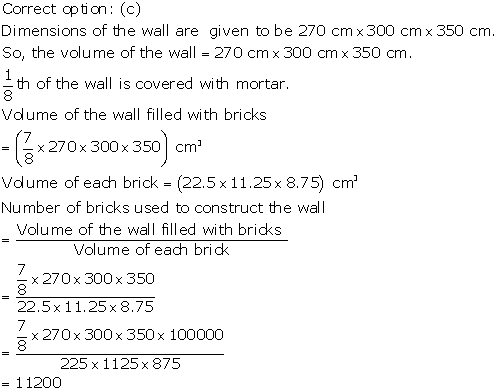
Solution 27
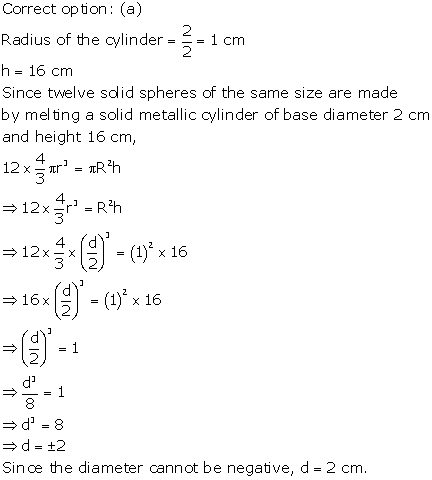
Solution 28
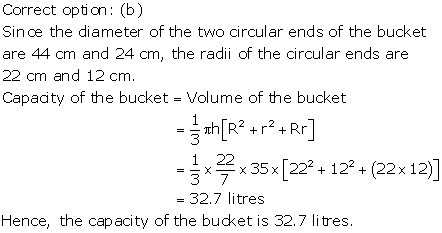
Solution 29
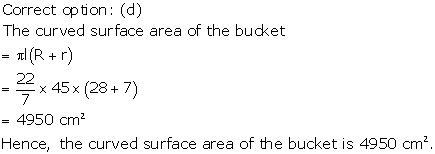
Solution 30
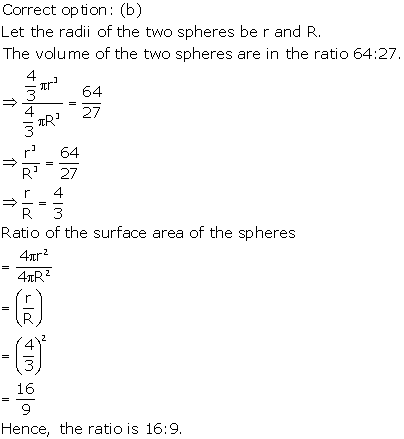
Solution 31
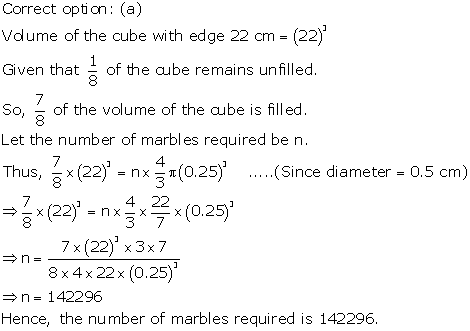
Solution 32
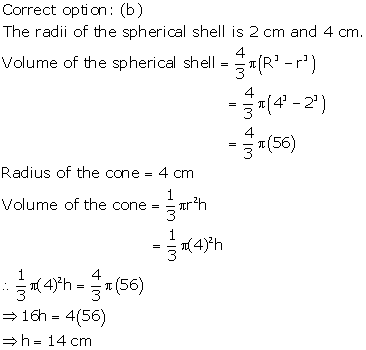
Solution 33
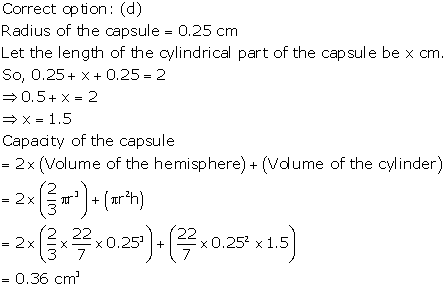
Solution 34
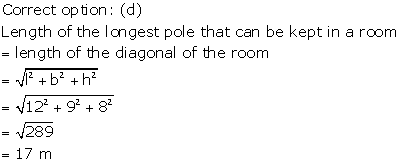
Solution 35
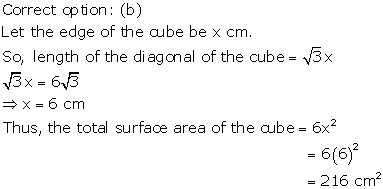
Solution 36
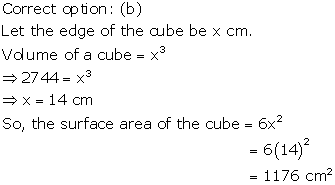
Solution 37
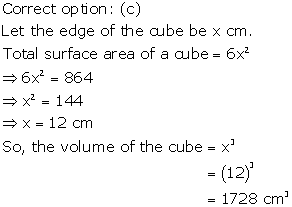
Solution 38
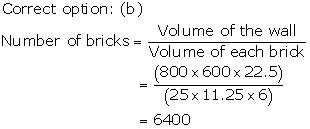
Solution 39
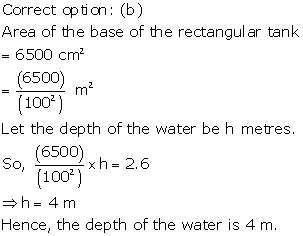
Solution 40
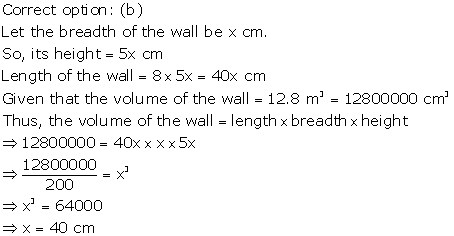
Solution 41

Solution 42
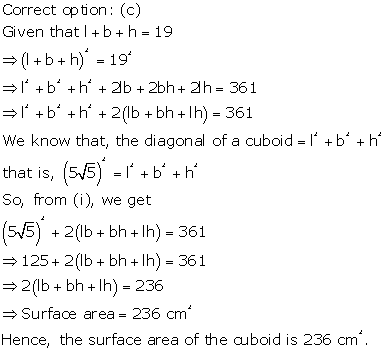
Solution 43
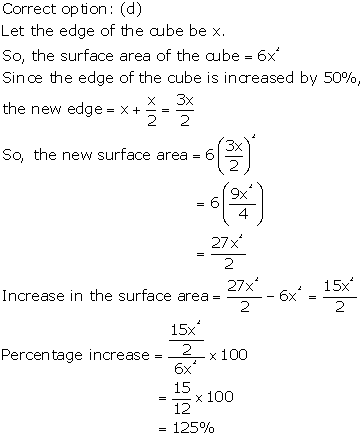
Solution 44
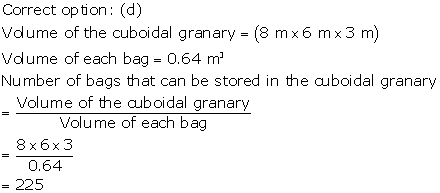
Solution 45
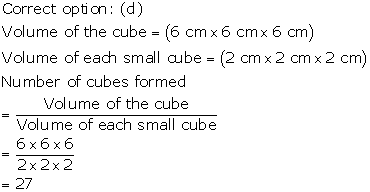
Solution 46

Solution 47
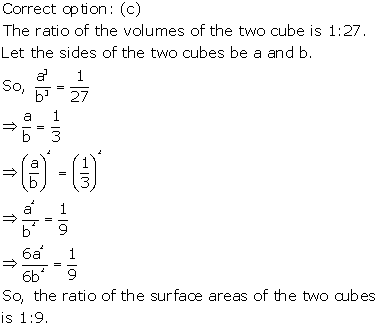
Solution 48

Solution 49
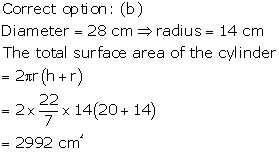
Solution 50
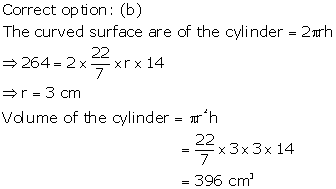
Solution 51
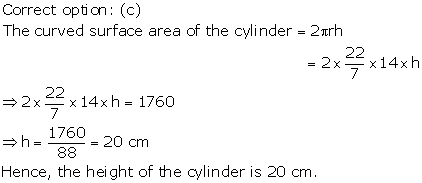
Solution 52
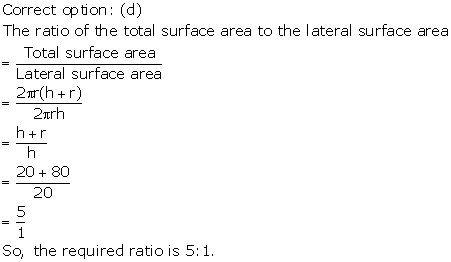
Solution 53
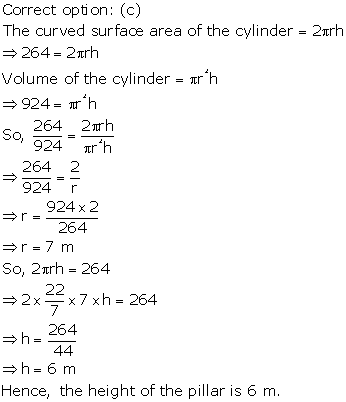
Solution 54
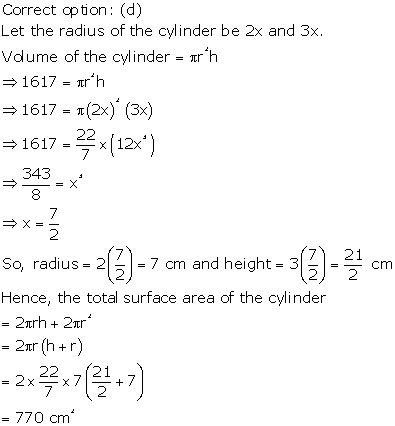
Solution 55
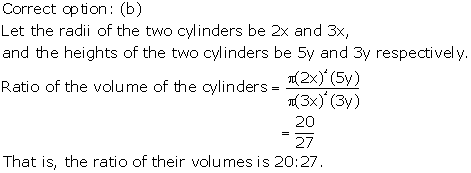
Solution 56
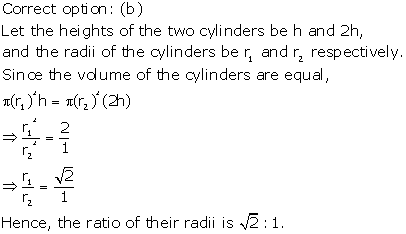
Solution 57
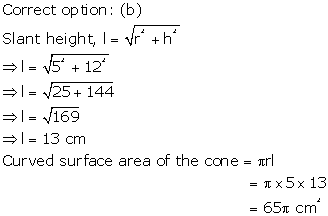
Solution 58
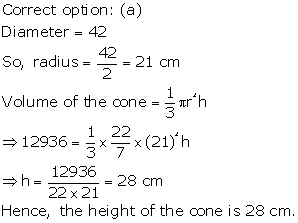
Solution 59
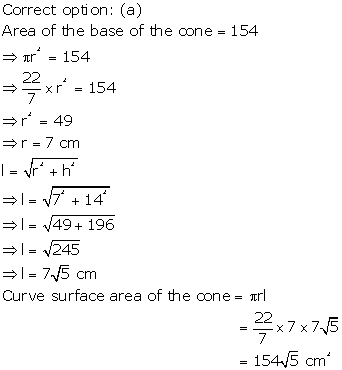
Solution 60
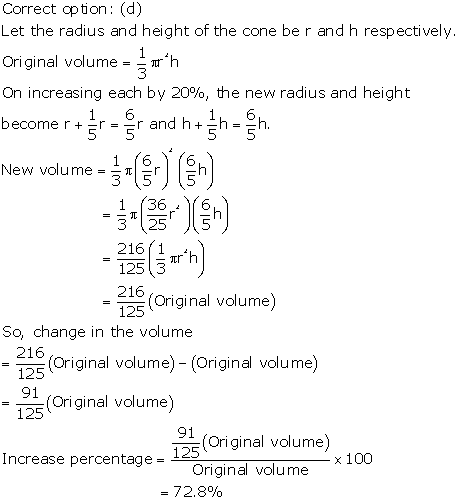
Solution 61
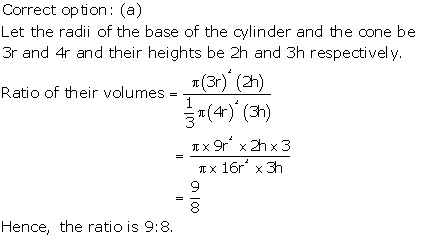
Solution 62
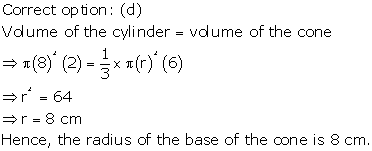
Solution 63
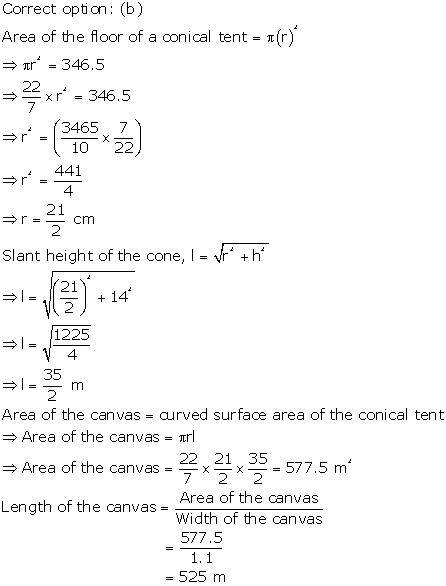
Solution 64
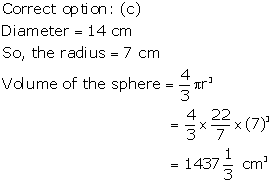
Solution 65
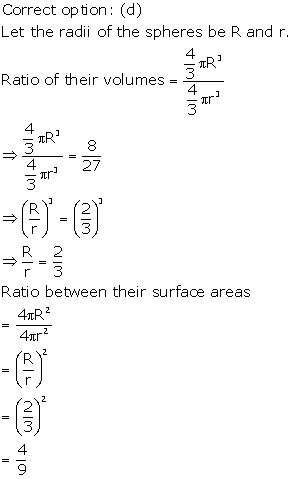
Solution 66

Solution 67
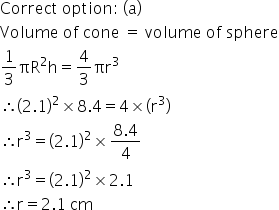
Solution 68
Correct option: (a)
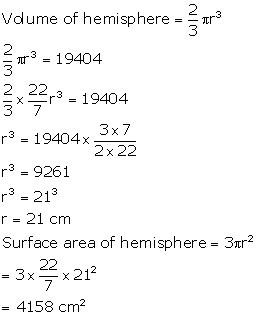
Solution 69
Correct option: (a)
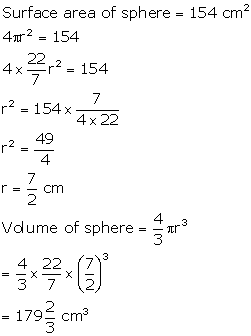
Solution 70
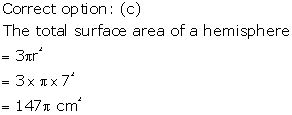
Solution 71
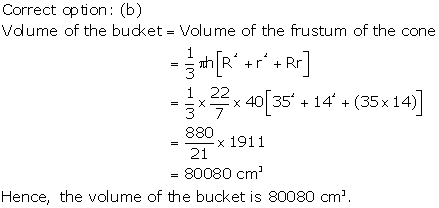
Solution 72
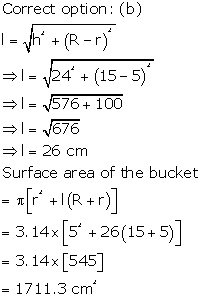
Solution 73
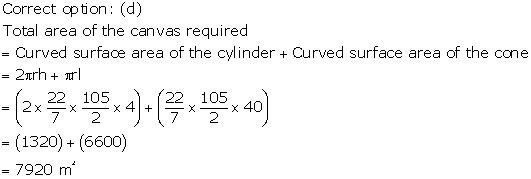
Solution 74

Solution 75
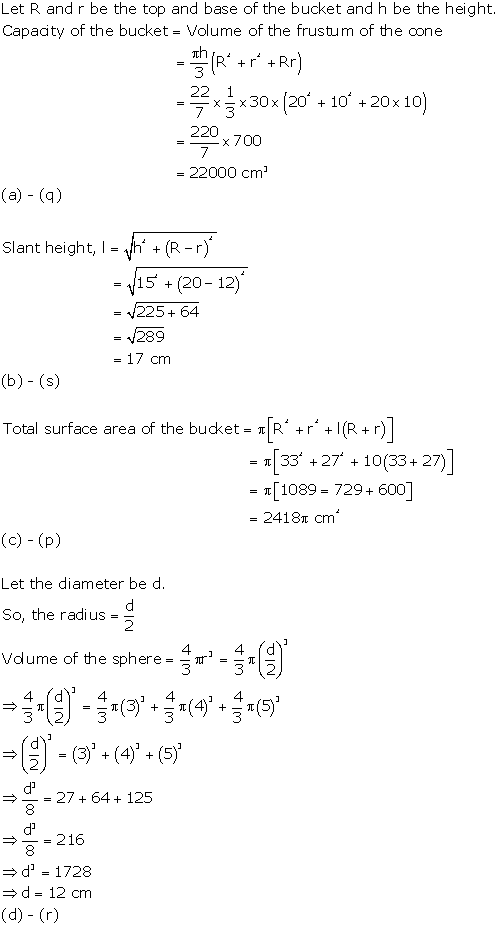
Solution 76
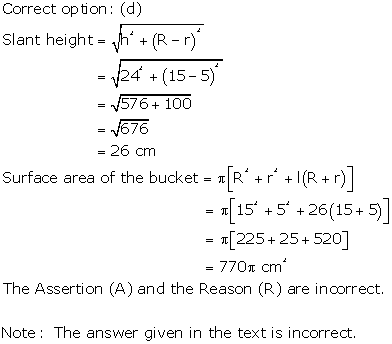
Solution 77
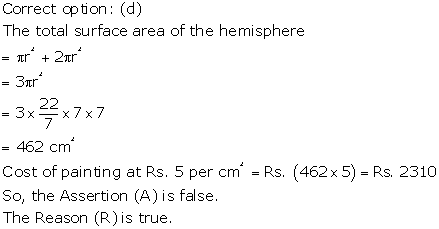
Solution 78
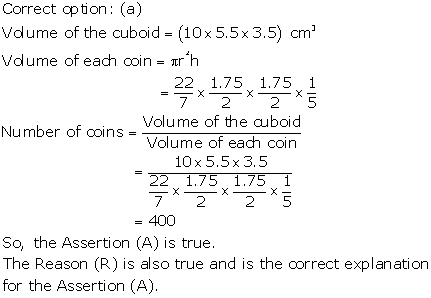
Solution 79
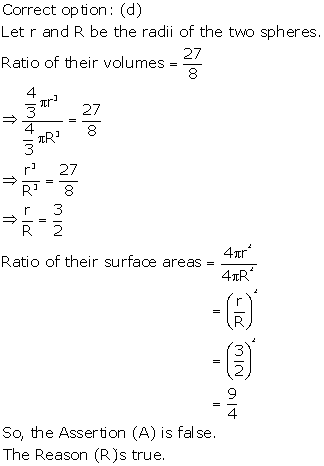
Solution 80
